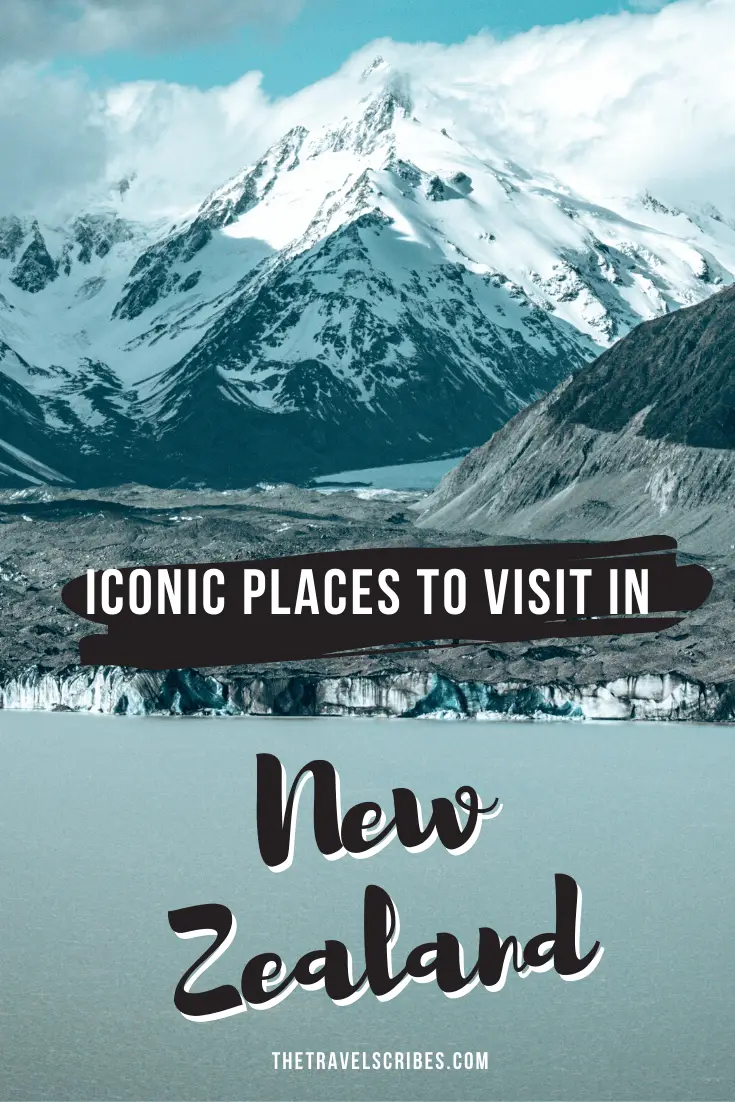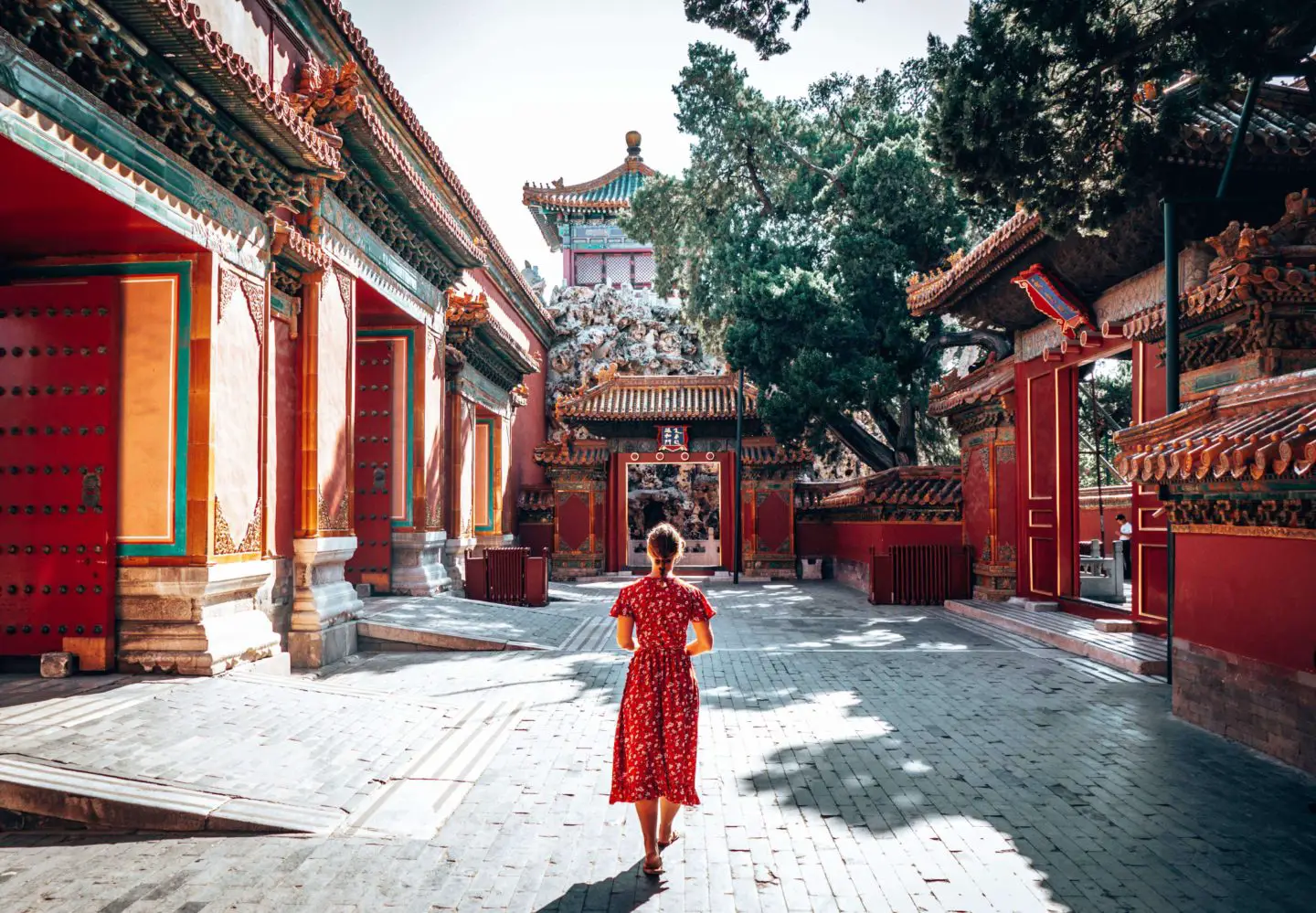One of the most naturally stunning places on earth, New Zealand has remained relatively undeveloped (compared to many western countries) due in part to its faraway location, around 2,000 km east of Australia. Given its remoteness, it was only inhabited by humans with the first Maori people arriving sometime between 1250 and 1300, with European settlers much later in the 1800s. So unsurprisingly, and given that the land is so far from everywhere (think a good 3 hour flight from Australia), most of the major iconic places and landmarks in New Zealand are natural wonders.
We’ve asked some of the globe’s top travel bloggers to give us their favourite iconic spots, famous monuments and gorgeous scenic locations that are absolute must-visit on any New Zealand itinerary. Read on to find out which of these landmarks and places made it onto the list…
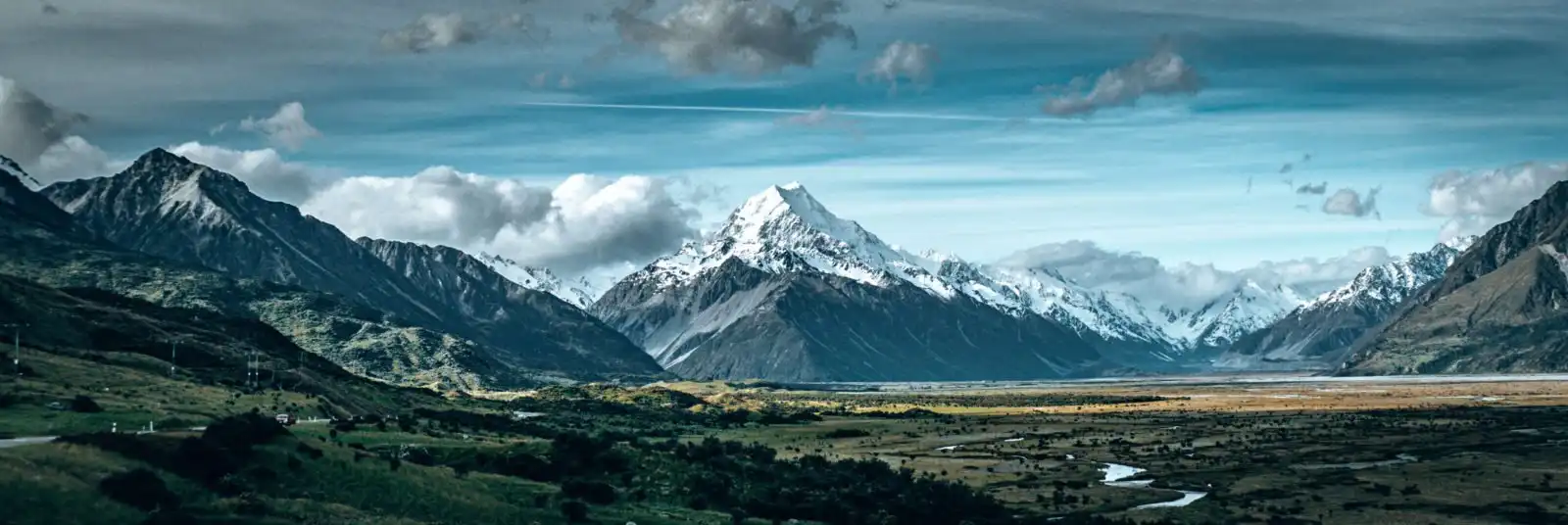
Read next: Check out whether any of these made it onto the most famous landmarks around the world list!
Skip ahead
Our top 10 landmarks in New Zealand
- Sky Tower, Auckland
- Milford Sound, Fiordland
- Aoraki / Mount Cook, Canterbury
- Lake Tekapo, Canterbury
- Franz Josef Glacier, West Coast
- Hobbiton, Waikato
- Moeraki Boulders, Moeraki
- Huka Falls, Taupo
- Marlborough Vineyards
- The Beehive, Wellington
Sky Tower, Auckland
Explored by Laura from Travel World Kids
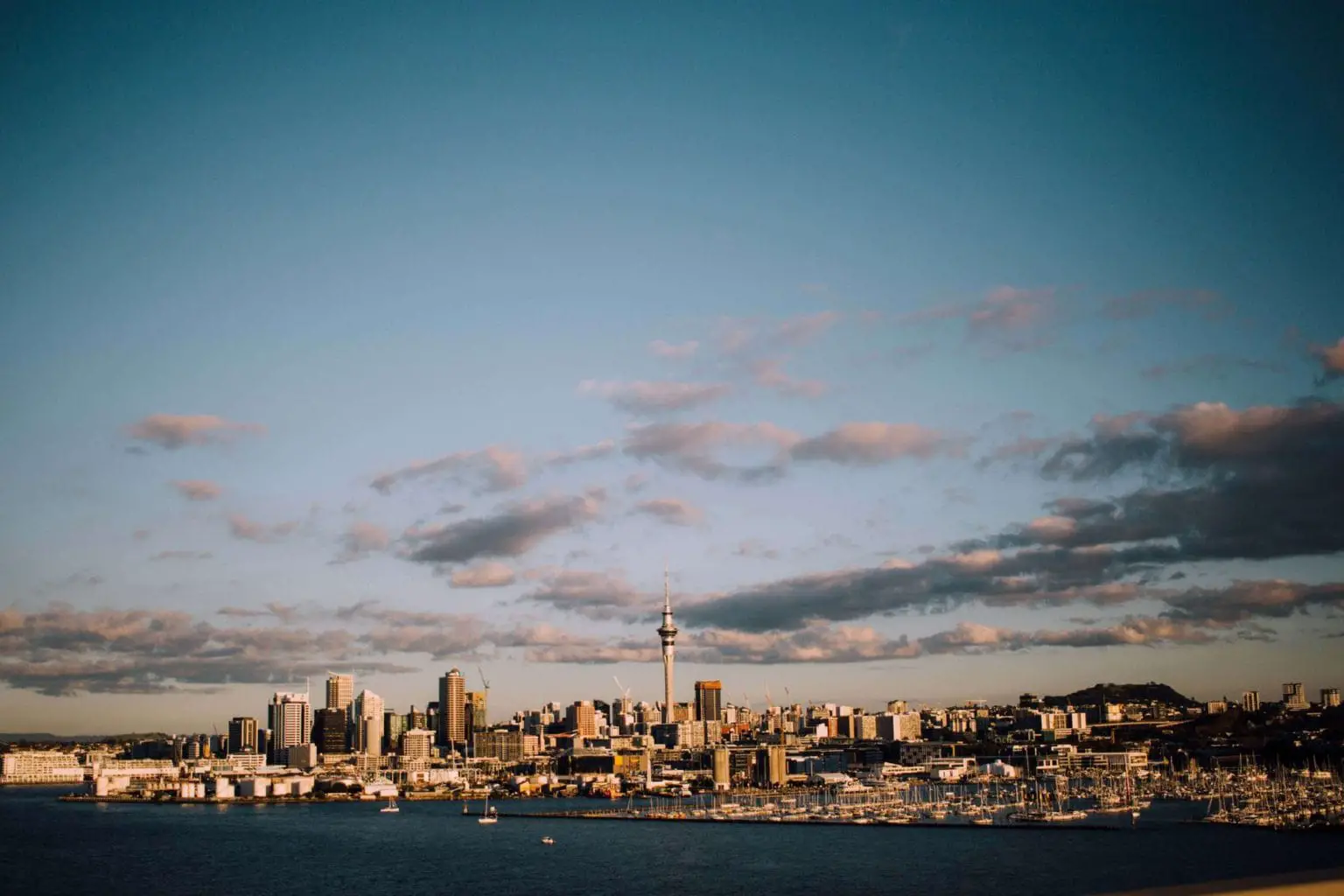
Auckland’s Sky Tower is in the heart of the city, it’s one of Aotearoa’s most recognisable landmarks and at 328 metres high, it’s the tallest building in the Southern Hemisphere. Entry is $32 for an adult, $13 for children aged 6 to 14, and free for those 5 years old and under, you can buy tickets online or onsite. The Sky Tower is open between 8:30am and 10:30pm and the later you visit the better – watching the sun set over the city is a magical experience.
When you arrive, ride the glass floored lift to the Sky Deck viewing platform, 220 metres above Auckland, where you’ll have stunning 360 degree views of the city and the Hauraki Gulf. If you’re feeling peckish pop down to the Sky Cafe and try the delicious award-winning New Zealand made Kapiti cheeses, or taste the iconic Hokey Pokey ice cream.
For the adrenaline junkies, the 192 metre SkyJump bungy, or the 360* SkyWalk will give you the thrill you’re looking for.
To make your visit to the Sky Tower even more memorable, dine at The Sugar Club by Peter Gordon, or New Zealand’s only 360-degree revolving restaurant, Orbit. The Sugar Club’s tasting menu showcases locally sourced produce and meat, with the option to pair New Zealand wines from some of the top wineries in the country. Orbit offers a unique experience, the dining room rotates once every hour showcasing the incredible views.
Also, if you want a different view of the Sky Tower, definitely head to One Tree Hill, which offers a great vista of the iconic monument.
A little Kiwi tip: Booking at either restaurant includes complimentary admission to the Sky Deck viewing platform, so why not spend a little more and not only see the stunning view the Sky Tower offers, but taste the award winning kai too?
Fox Glacier, West Coast
Explored by Christina from Travel2Next.com
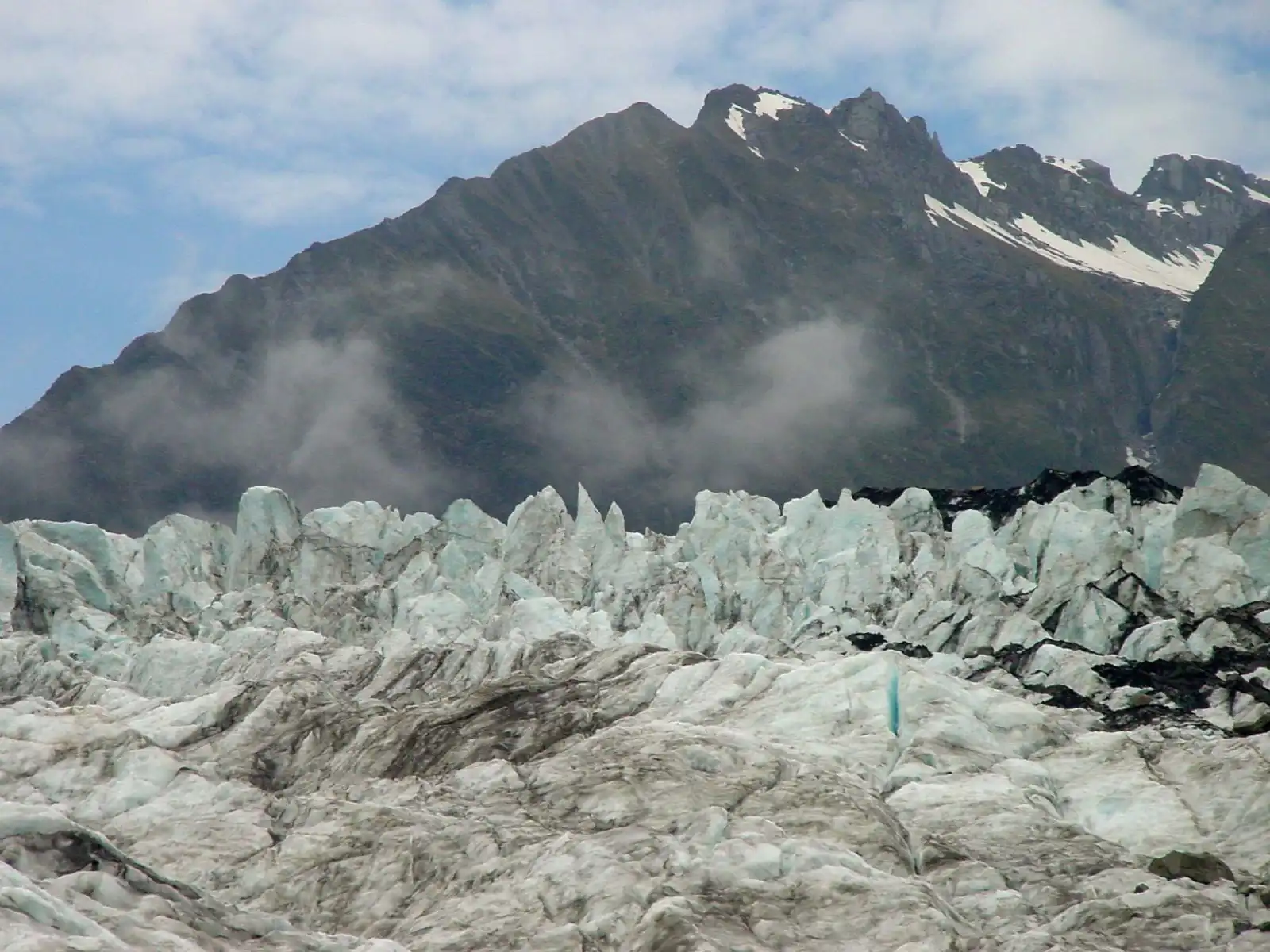
Fox Glacier is both the name of a glacier and a town, which was named after Sir William Fox who served as the Prime Minister of New Zealand between 1869 and 1872. The town sits at the foothills of New Zealand’s Southern Alps and is the gateway to adventure activities involving the glacier, such as glacier hikes, scenic flights and walks. Fox Glacier starts in the Southern Alps and stretches down into temperate rainforest 300 m above sea level.
The glacier is the main attraction and a famous landmark in New Zealand, and there are several ways to see or experience it. You can gaze at the magnificent river of ice from a viewpoint (the best place to see it is on Cook Flat road as you head towards Lake Matheson), go ice-hiking, take a scenic flight and try ice climbing. A bucket list experience for adventure seekers is heli hiking, which combines a walk on the glacier with the adrenaline rush of flying in a helicopter above it, or ice climbing. Landing on the glacier offers the chance to see arches and ice caves.
Other things to see around Fox Glacier are the glow worm caves located near the town centre and Lake Matheson, which is one of the most beautiful lakes in New Zealand. The reflection of Mount Cook in the lake is a sight to remember. There are also amazing hiking trails around the lake with lovely views. Not far from Lake Matheson is Gillespies Beach, which is a historic gold mining settlement that’s now home to fur seals.
Hobbiton, Waikato
Explored by Lee from the Travel Scribes
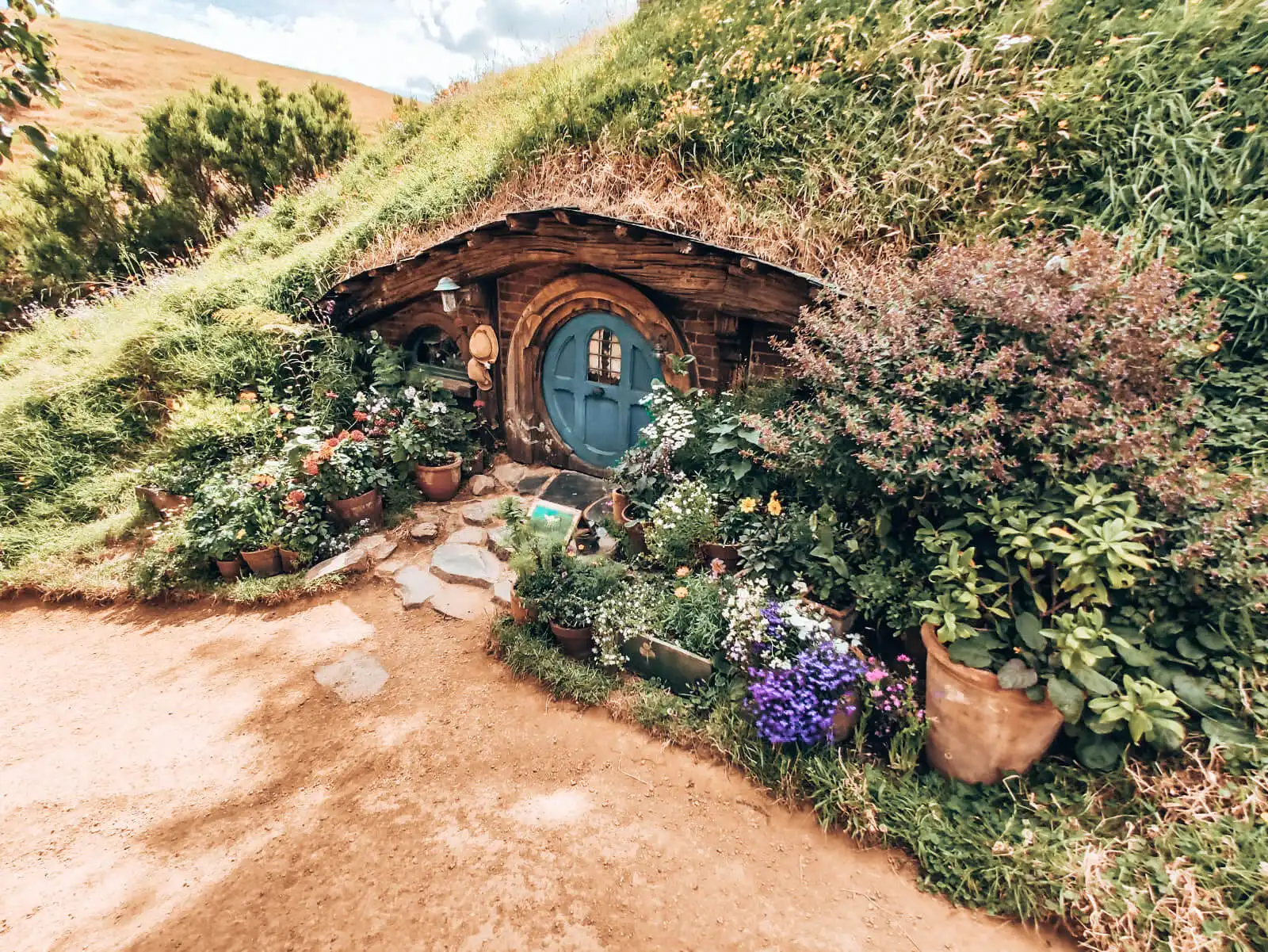
Any Lord of the Rings or Hobbiton movie fan will tell you that this is the biggest landmark they want to see in New Zealand; after all it’s one of the fastest growing attractions in the country!
Situated outside the small town of Matamata and in driving distance of both Auckland and Rotorua, Hobbiton is the movie set for the films, built permanently in late 2009. You can tour it (and we do suggest do! Book it here) including a guided tour with a top-notch film buff, enough pictures of Hobbit holes to last a lifetime and a nice zesty cup of hobbit cider at the Green Dragon pub to end your afternoon.
The history of this landmark is pretty cool. In the late 1990’s a location scout was flying over the fields near Matamata, looking for the perfect place to film Lord of the Rings. He saw the Alexander farm and he, plus filmmaker Peter Jackson, promptly arrived to meet the farmer and ask if they could lease land for the films. After the original LOTR films were done, they broke down the set only for avid fans to try and get onto the property to see the ‘remnants’ of their beloved Hobbiton. So when the film crews needed to return in 2009 to film the Hobbiton trilogy, they decided to build a permanent set and open it to tours, which now sees thousands of tourists flock there every day.
Hobbiton is best visited as part of a trip to the awesome town of Rotorua. If you’re heading there, we recommend our Rotorua itinerary, which has all the info you’ll need!
Related: Guide for planning your New Zealand North Island itinerary!
Mount Cook, Canterbury
Explored by Caroline from CKTravels
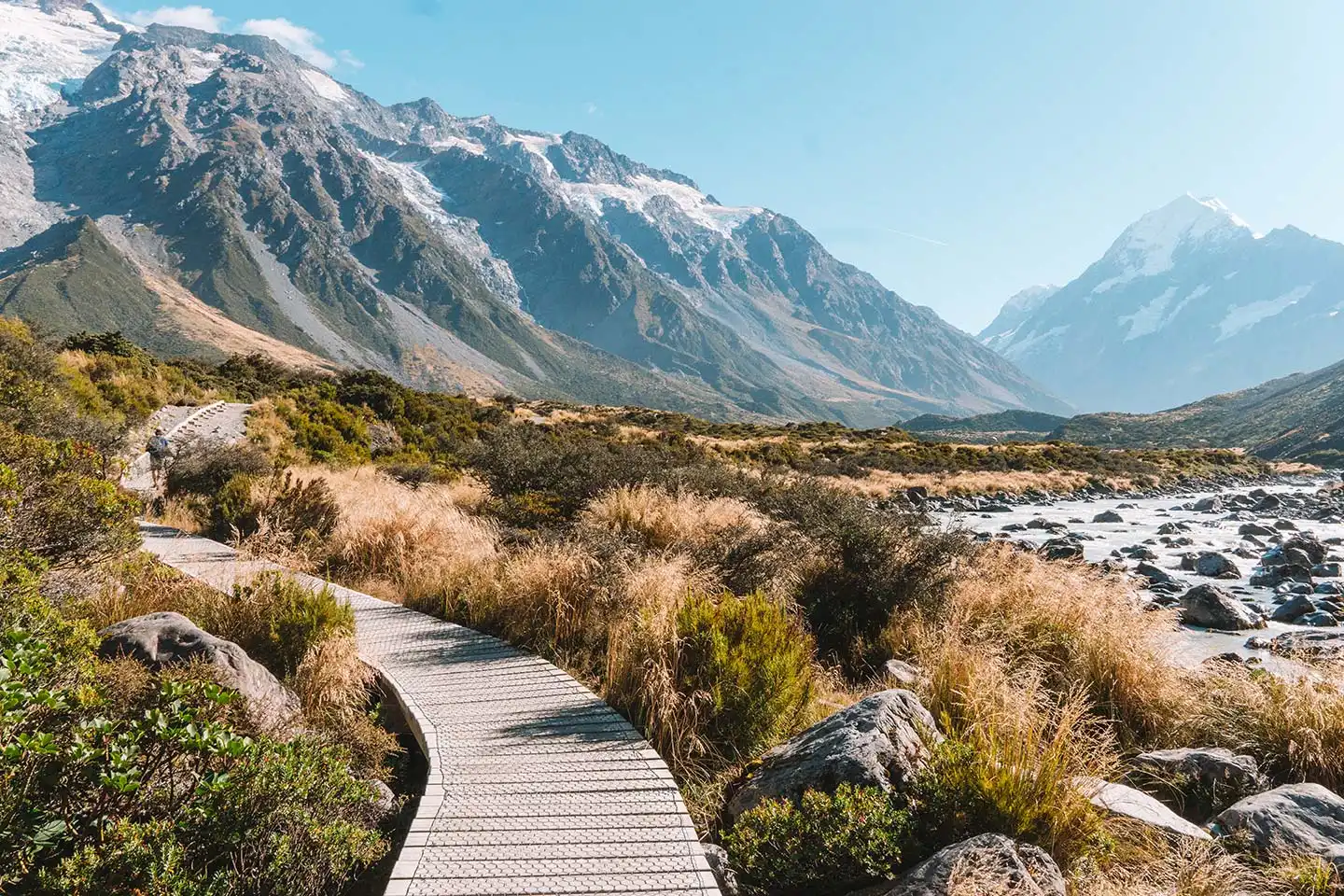
Mount Cook National Park is located in the south island and is home to New Zealand’s highest mountain, Mt Cook. It has some of the country’s most incredible landscapes – from the snow-capped mountains by day to the twinkling stars at night, Mount Cook should be part of every south island road trip.
To explore the area you will need to base yourself in Mount Cook Village (located approximately halfway between Queenstown and Christchurch). There are only a handful of hotels so you will need to book your accommodation well in advance during peak season.
From the village you can then take a short drive to the start of some epic walks. The most popular is the Hooker Valley Trackdue to its easy access along the Hooker River and it’s incredible mountain and lake scenery. The trail is approximately 5 kilometres long and is around 3-4 hours return and suitable for all levels of fitness.
Other fun activities you can book in Mount Cook include a heli hikewhere you can fly in a helicopter for breath-taking views of the national park, then land on the Tasman glacier for the ultimate hiking experience. Alternatively you take a Tasman Glacier lake boat trip, which takes you up close and personal to some large icebergs in the Tasman lake.
Rotorua’s Geothermal Parks
Explored by Alex from Discover Aotearoa
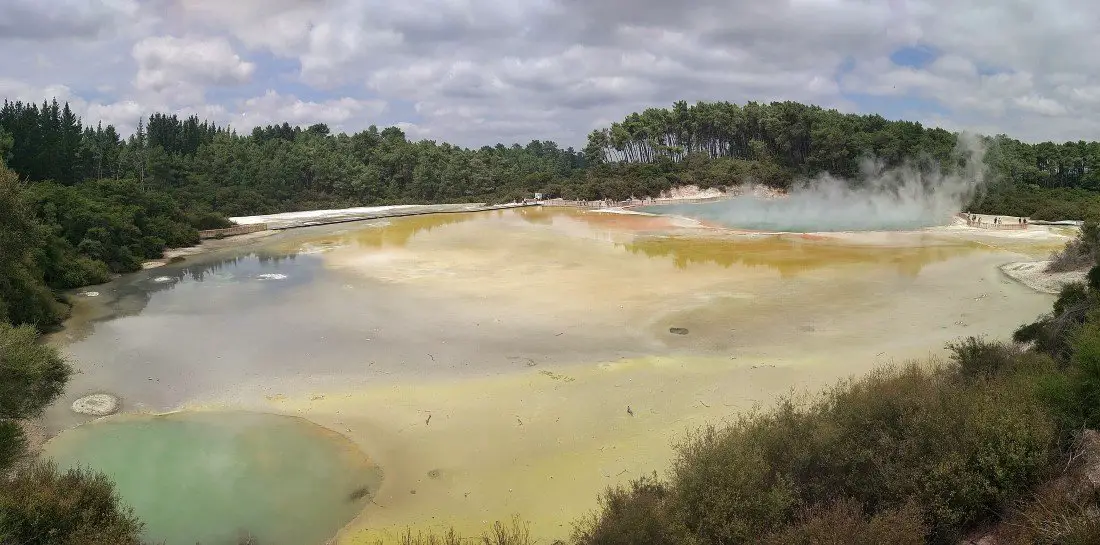
Confession: Rotorua is my favourite place in New Zealand by far! It’s not only the adventure capital of the North Island and the hub for experiencing Maori culture. It also has this iconic landscape that makes Rotorua a place like no other in New Zealand.
As you get closer to Rotorua, you’ll notice a whiff at first, then often a full-on, in-your-face cloud of…rotten eggs. Or sulphur, really. The city sits on a particularly thin earth crust and is located in the Taupo Volcanic Zone, which means literally everywhere in and around Rotorua, the earth steams, mud bubbles, (some) lakes discolour and so might your silverware.
There’s a lot of regular, very lush, nature around Rotorua, too. There are so many lakes, beautiful walks and the bike trails make it a mountain biking Mecca. But I love most walking through the geothermal landscape and I’ve visited all thermal parks, both free and paid for. It’s fascinating to watch what should really be inside the earth but somehow managed to escape and create all these lovely colours.
When you visit New Zealand, you should definitely make enough time to visit Rotorua’s geothermal parks!
Akaroa and the Banks Peninsula
Explored by Tom from The Travelling Tom
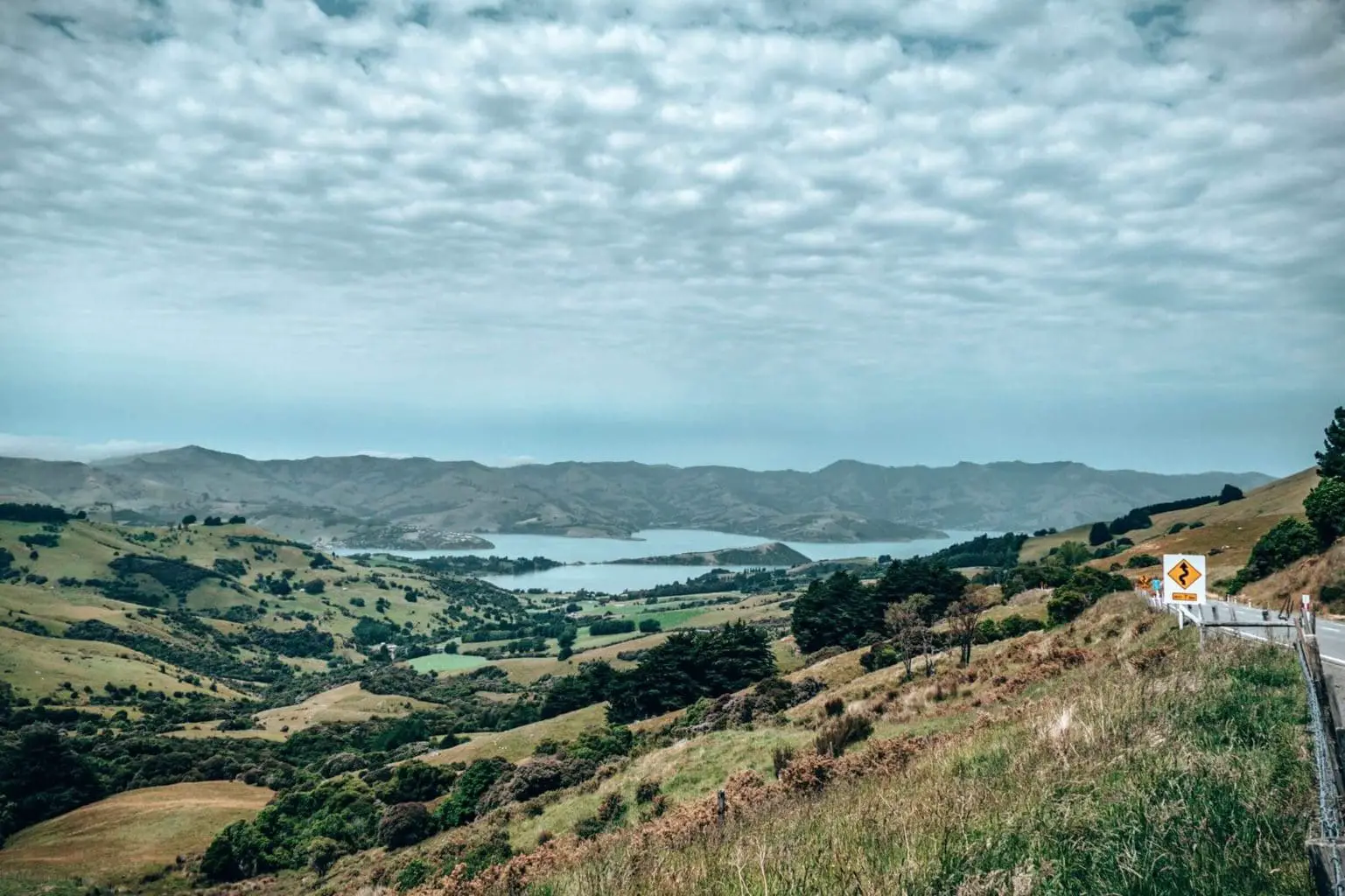
The Banks Peninsula is one of the most beautiful places to visit in New Zealand. Located to the south of Christchurch, it is a stunning area that will leave you breathless as you marvel at the incredible views!
The Banks Peninsula was formed from the remains of an ancient volcano which span 1,150 square kilometres (440 sq mi) encompassing two harbours and many coves and bays.
If you want to appreciate the beauty of the Banks Peninsula, there are two places you need to check out, Akaroa and Lyttelton Bay. Akaroa is a town that is located on one of the two harbours. It’s set in a stunning location, with incredible views from almost anywhere. There is a lot to do here, such as kayaking in the harbour, cycling in the hills or just enjoying the views!
Heading to Lyttleton is one of the best things to do in Christchurch. Like Akaroa, the views are incredible and it is well worth hiking up the Bridle Path to see the harbour below. Alternatively, you can take the gondola to the top for an even more scenic journey! You can also go to Godley Head for some more breathtaking views and check out the old army barracks located there.
The Banks Peninsula is home to some of the most spectacular scenery in New Zealand and it’s an area you can’t afford to leave off your itinerary while you’re in the country.
Franz Josef Glacier, West Coast
Explored by Derek from Robe Trotting
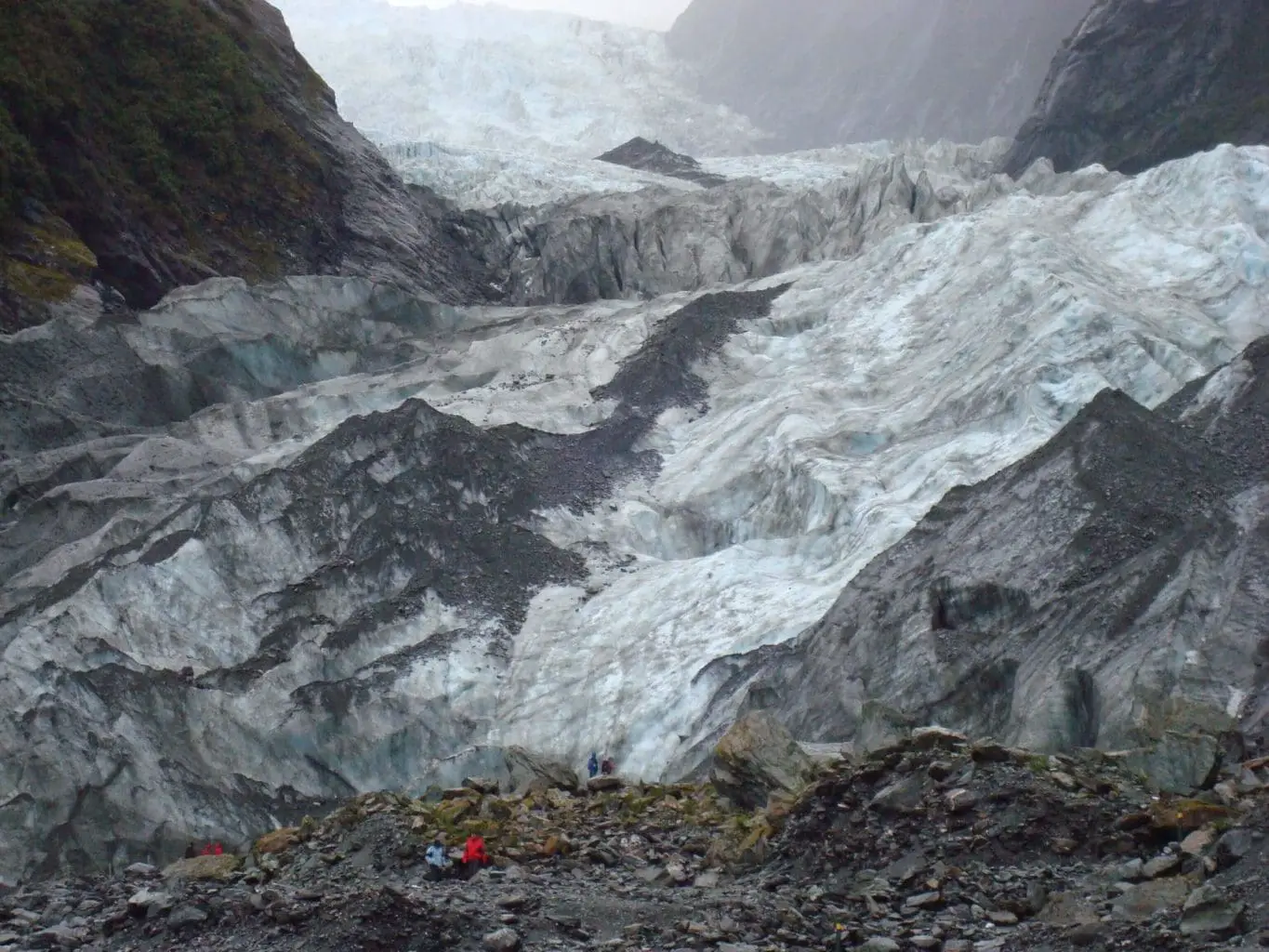
The Southern Alps dominate the South Island of New Zealand, always looming in the background and providing the stage of so many amazing landmarks. But few places show the dynamism of New Zealand like the Franz Josef Glacier.
The drive here alone is worth a visit, as it sits five hours from either Christchurch or Queenstown. From Christchurch, you can have beautiful views as you cross the Alps at Arthur’s Pass, while the drive from Queenstown takes you through an amazing mix of scenery, including glacier country, the western coast, and the Otago plains. Your base of operations is Franz Josef village, a basic tourist town with the necessary amenities.
There are essentially two ways to experience the glacier – by foot, and by helicopter. A 90-minute hike takes you near the glacier (due to its rapid retreat, the face is too dangerous to approach). The hike takes you through a moonscape of boulders and loose rocks, along a turquoise blue stream of meltwater passing, and has waterfalls (and sometimes rockfalls) coming down the walls of the valley.
But the most dramatic way to experience the glacier is a heli-hike. This is not a cheap experience (most tours are about 325 USD/250 GBP), but you will get to strap on crampons, jump into a helicopter, and land on an actual glacier. The ride provides spectacular views of the glacier and surrounding mountains, and on the glacier, you get to hike through a unique ice world, with narrow passages, ice caves, and crevasses that you will never forget. But be warned that the weather here is highly variable, and fog or rain may cause your flight to be canceled or delayed.
Recommended: Check out the most scenic drive in New Zealand, the Christchurch to Queenstown road trip.
Huka Falls, Taupo
Explored by James from the Travel Scribes
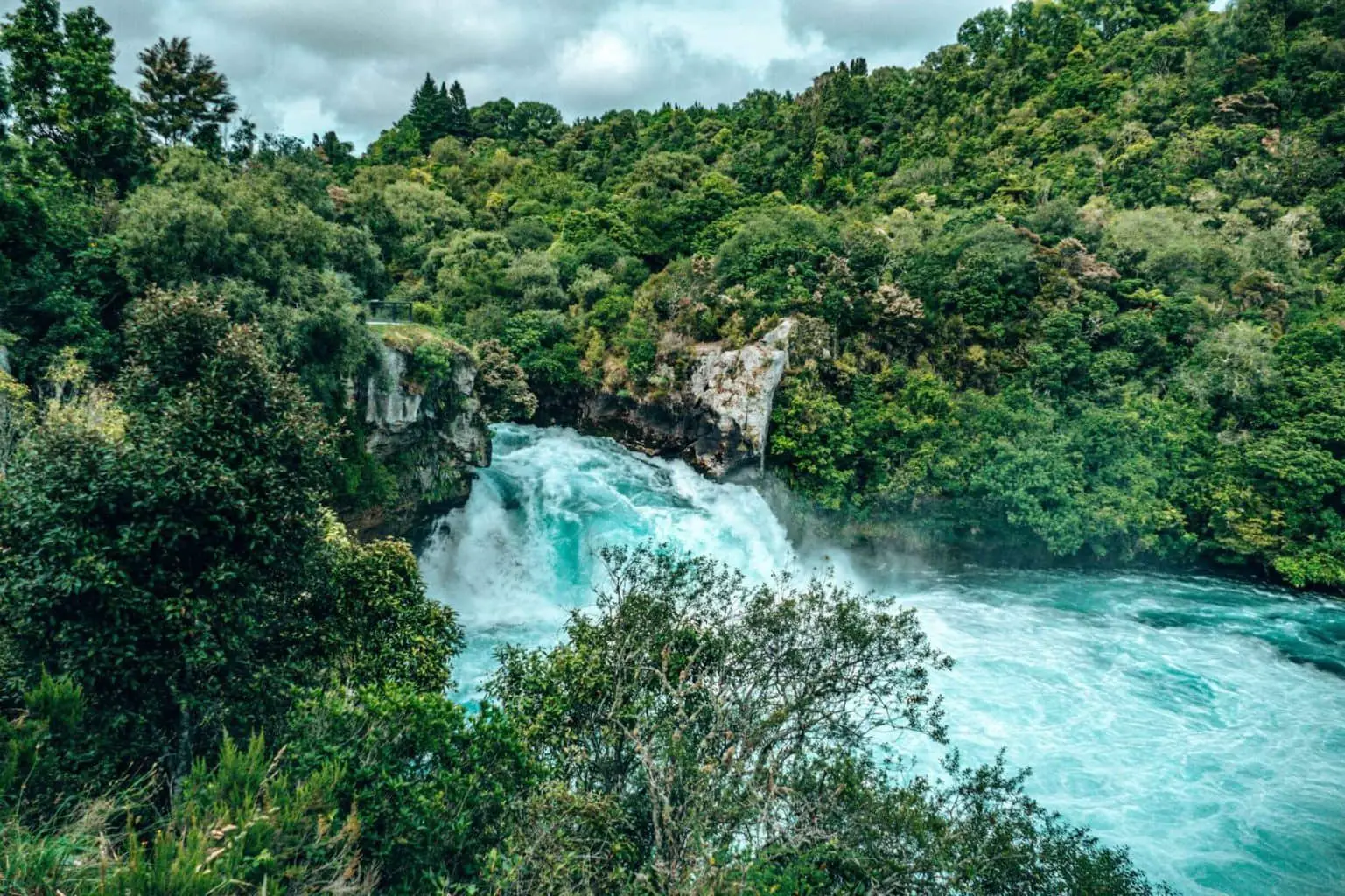
The most visited natural landmark in New Zealand, Huka Falls is one of the most impressive waterfalls that we’ve been lucky enough to visit. The turquoise blue cascading falls set on the Waikato River, drain all the way into Lake Taupo.
The waterfall is extraordinarily powerful, with over 200,000 litres of water crashing over the final 6 metre drop every second. To put that into context it would fill 5 Olympic sized pools every minute!
What’s even better, is that to get to the falls from town is a relatively easy hike along the beautiful river, that will take only around an hour to complete. And once you’re back from your trek you’re also able to stop in at the thermal pools that line the river for a dip!
Cape Reinga National Park
Explored by Bistra from The Magic of Traveling
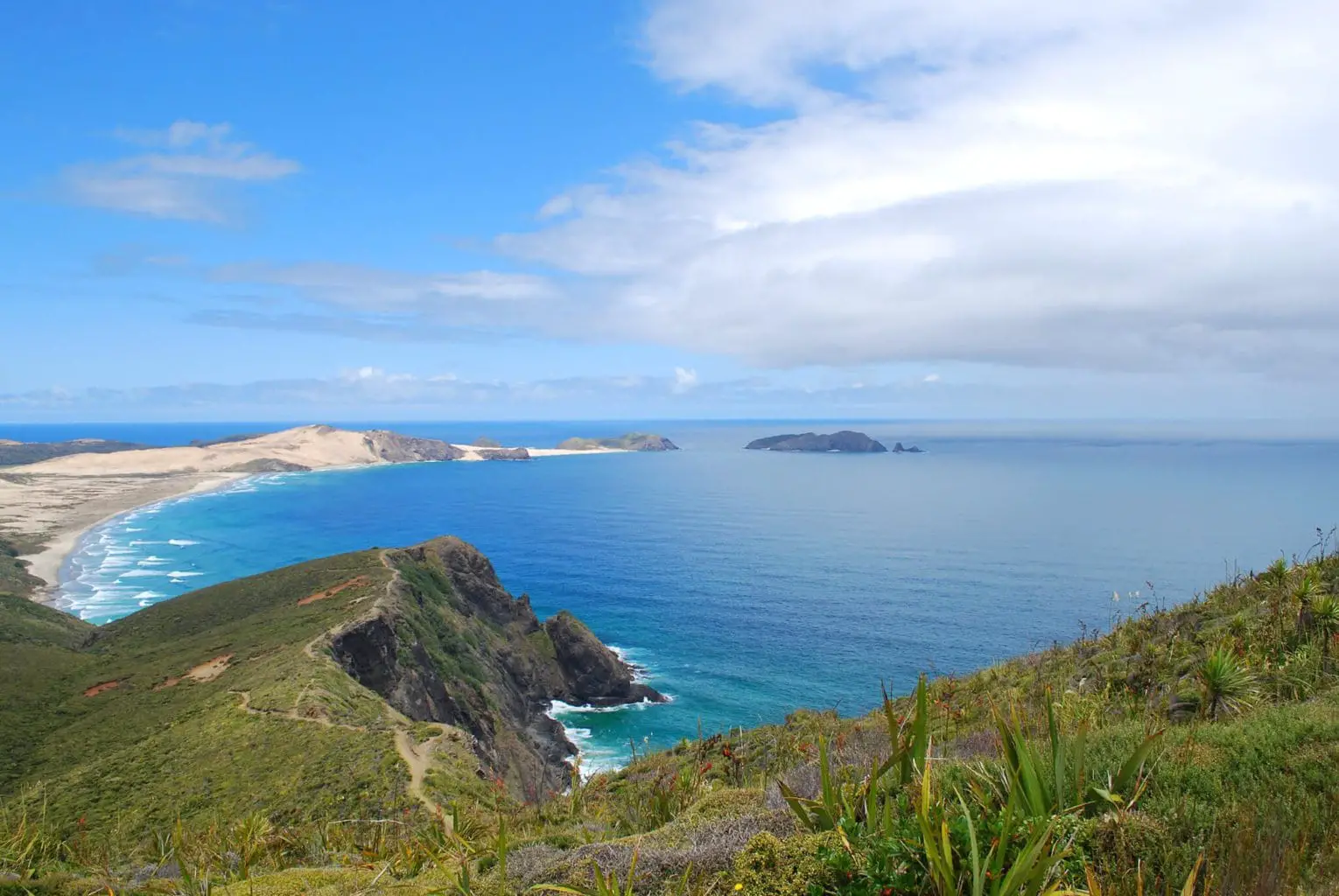
Cape Reinga is hiding in the northernmost part of New Zealand where the Tasman Sea meets the Pacific ocean. You are welcome to enjoy that encounter! It’s amazing to tramp the hiking trails in the national park, to enjoy the views, to reach the lighthouse and to admire the rich flora and fauna of Cape Reinga.
You can go there by yourself, park the car and start your outdoorsy Kiwi experience, or you can go on a tour. We highly recommend getting a local Maori guide for your time around. They will help you find hidden white beaches, the special ice-cream, or the ancient kauri trees. You can also camp in the designated areas in the Cape Reinga National Park.
Cape Reinga is one of those magical and iconic places that represent the beauty and tranquillity of New Zealand. We recommend a visit for at least a few days, but if you’re short on time – a day trip from Kerikeri will do the trick!
Christchurch Cathedral, Canterbury
Explored by Lee from the Travel Scribes
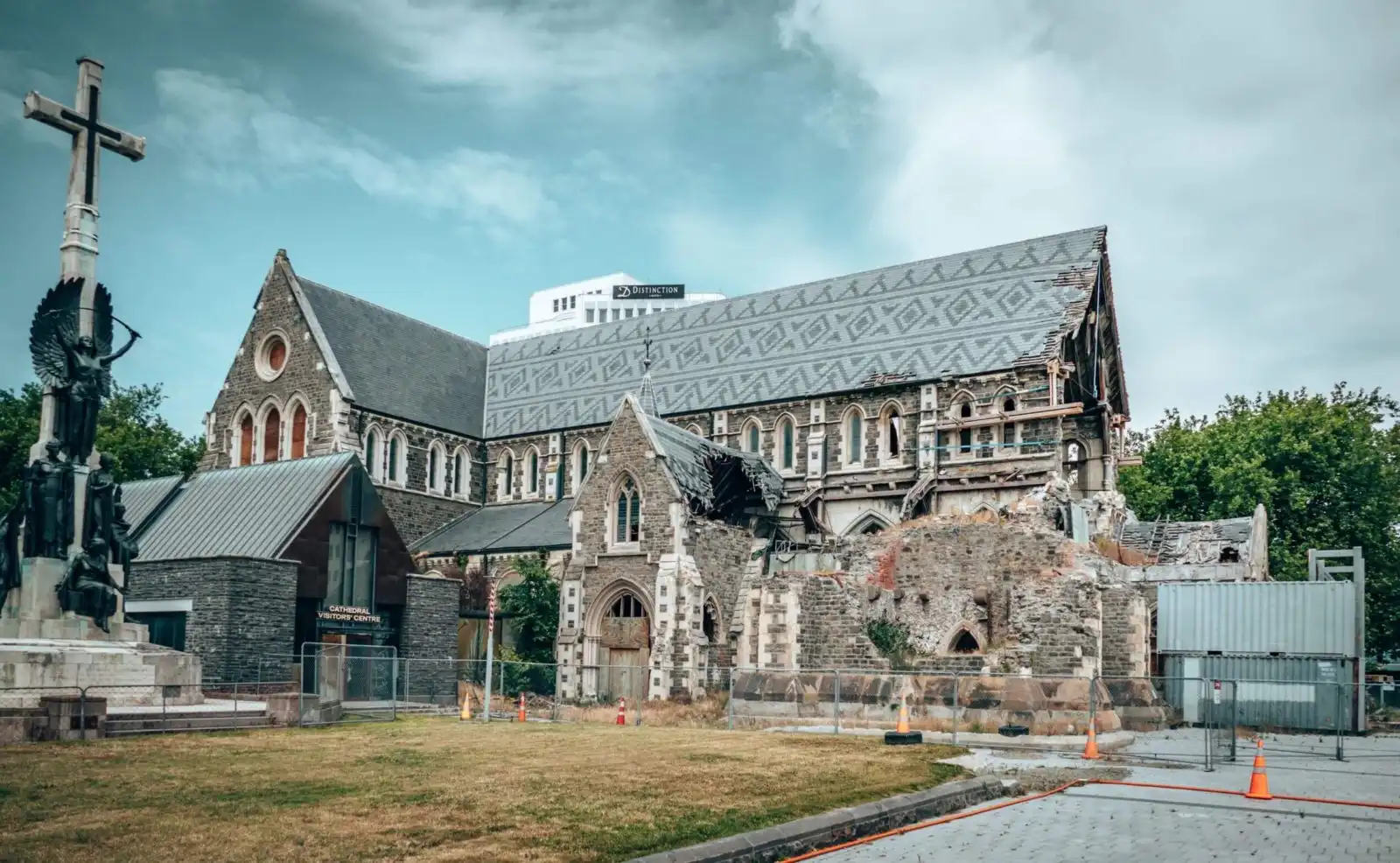
Currently in the midst of a rebuild after the devastating 2011 earthquakes, even though this beautiful cathedral isn’t open it’s definitely still of the most prominent New Zealand landmarks. Originally built between 1864 and 1904, this towering Anglican church was the cathedral seat of the Bishop of Christchurch.
Situated in the centre of town its still a huge landmark, regardless of the ruin. Essentially the church was hugely damaged in the earthquake, so much so that parts of it needed to be entirely demolished for safely. Today it stands behind thick steel gates, as its restored to its former glory.
To replace it while it’s rebuilt, the city created the unique and ingenious, Cardboard Cathedral, a transitional cathedral made out of – you guessed – hundreds of rolls of cardboard! That one is a definite must-see as part of your Christchurch itinerary, as it’s a multicoloured reminder of how people can overcome difficult circumstances.
Related: The ideal New Zealand South Island itinerary.
Mount Maunganui Beach, Mount Maunganui
Explored by Scott from 4 Degrees of Destination
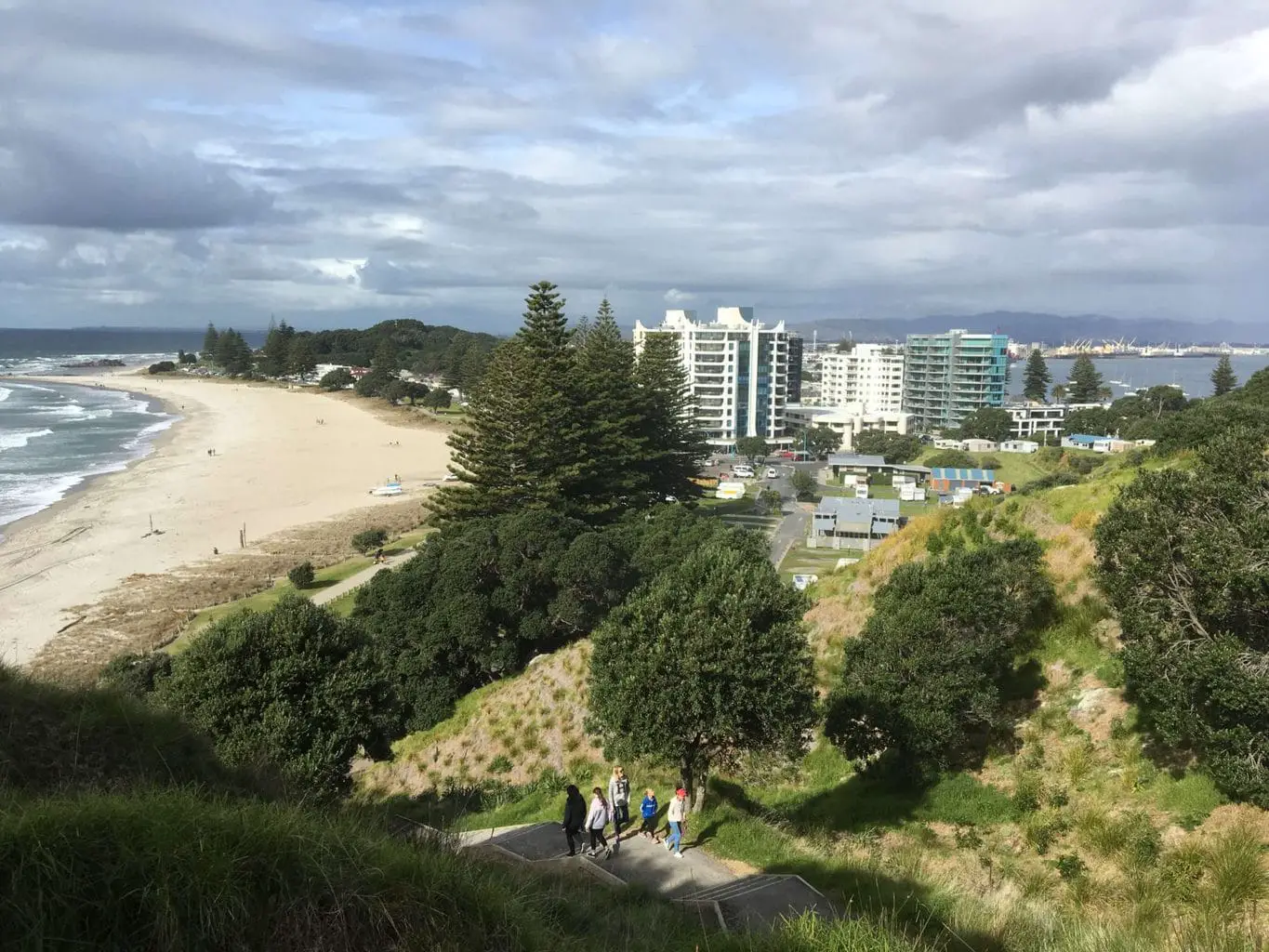
Mount Maunganui has been a popular holiday spot for locals and tourists alike for many, many years. In fact, my Dad holidayed here over 65 years ago. Since then it was changed and grown and is known as one of the best beach destinations in New Zealand.
Set on a peninsula, on one side you have a stunning Pilot Bay overlooking Tauranga harbour. There is plenty to do, take your pick from paddle boarding, kayaking, sailing, fishing off the wharf or just relaxing on the shores and taking a swim. Most summer days you’ll see cruise ships arriving and departing too. On the other side is Mount beach which stretches out as far as the eye can see. This is the perfect place to swim, boogie board or even learn to surf at one of the surf schools.
At the end of the peninsula stands the impressive Mauao, a 232m mountain. Here you can either walk to the top for the impressive views or stroll around the base. This is one of the most popular activities to do.
Right underneath Mauao is the Beachside campground, this is the perfect place to stay. Here you can pitch your tent, park your caravan or rent a cabin. The facilities here are first-class too. There are also plenty of cafes close by to get your morning coffee.
If you are checking out landmarks in New Zealand make sure to add Mount Maunganui and its beautiful beach to your list.
Milford Sound, Fiordland
Explored by Tayler from Traveling Tayler
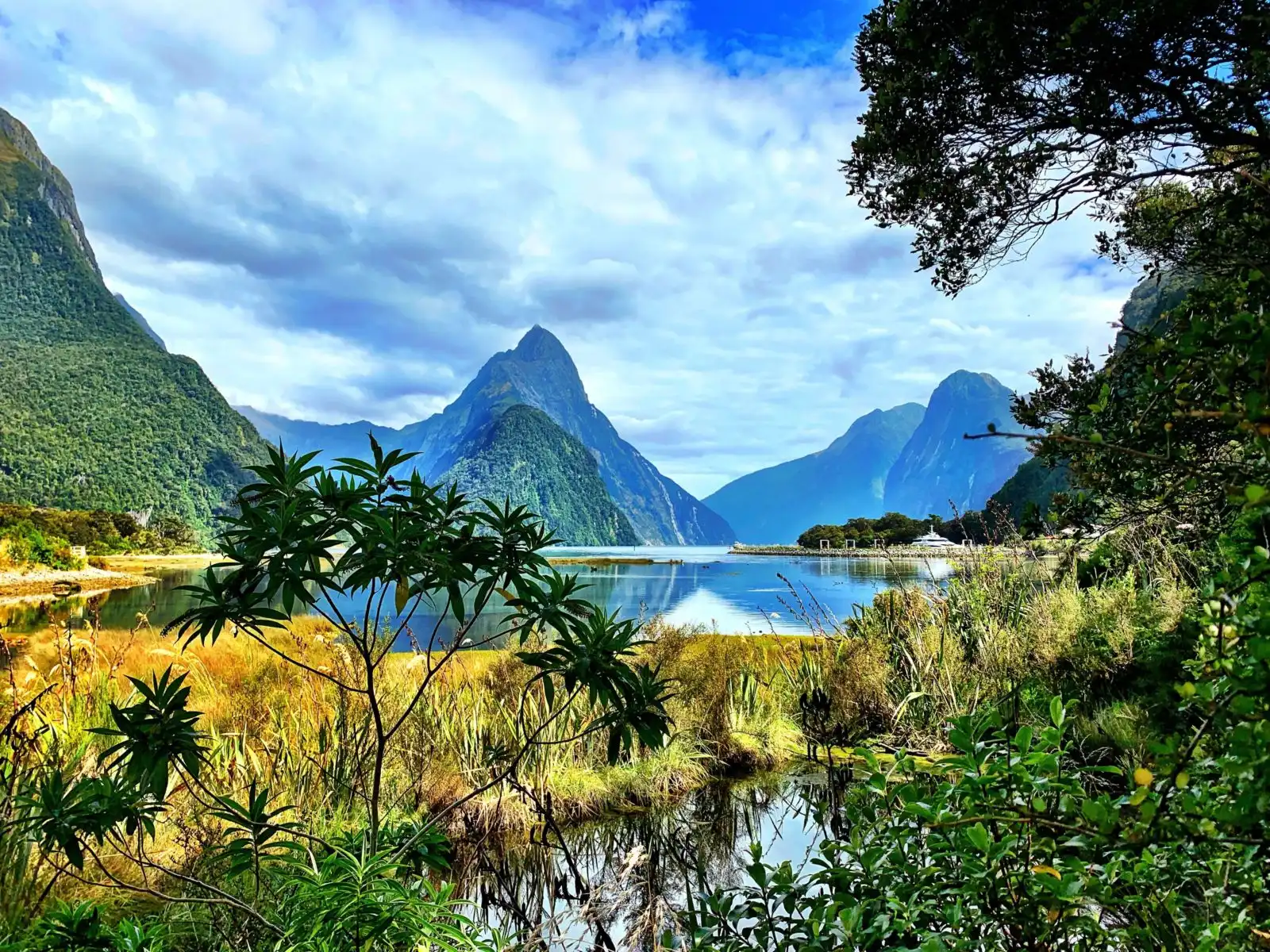
I had the pleasure of visiting Milford Sound twice during my travels through the New Zealand South Island. And each time, the scenery and splendour of the location were absolutely breath-taking.
The most famous New Zealand landmark in the Fiordland National Park, Milford Sound is located on the southwest coast of the South Island. Despite it actually being a fiord, and not a sound, it is a perfect destination for any visitor.
Boat tours through Milford Sound are the most popular option to explore it’s different features including high cliffs, forest greenery and waterfalls. It is also home to seal colonies which you will likely see sun-bathing on boulders and for the lucky visitors you may even catch a glimpse of swimming dolphins!
There are many tour operators running daily tours, so I would encourage any visitor to do their research ahead of time. Most of the tours are very similar in length and offerings, so there are plenty of options.
Because it is so remote, getting to Milford Sound can be challenging. For those with little time, there are day tours available from nearby Queenstown which typically include a boat tour ticket. For visitors looking to spend more time in Fiordland National Park (which I highly recommend) you can rent a car and stay in the town of Te Anau right on the edge of the park entrance.
No matter how you get there, Milford Sound is a must see landmark in New Zealand.
Lake Wanaka, Canterbury
Explored by April from The Unending Journey
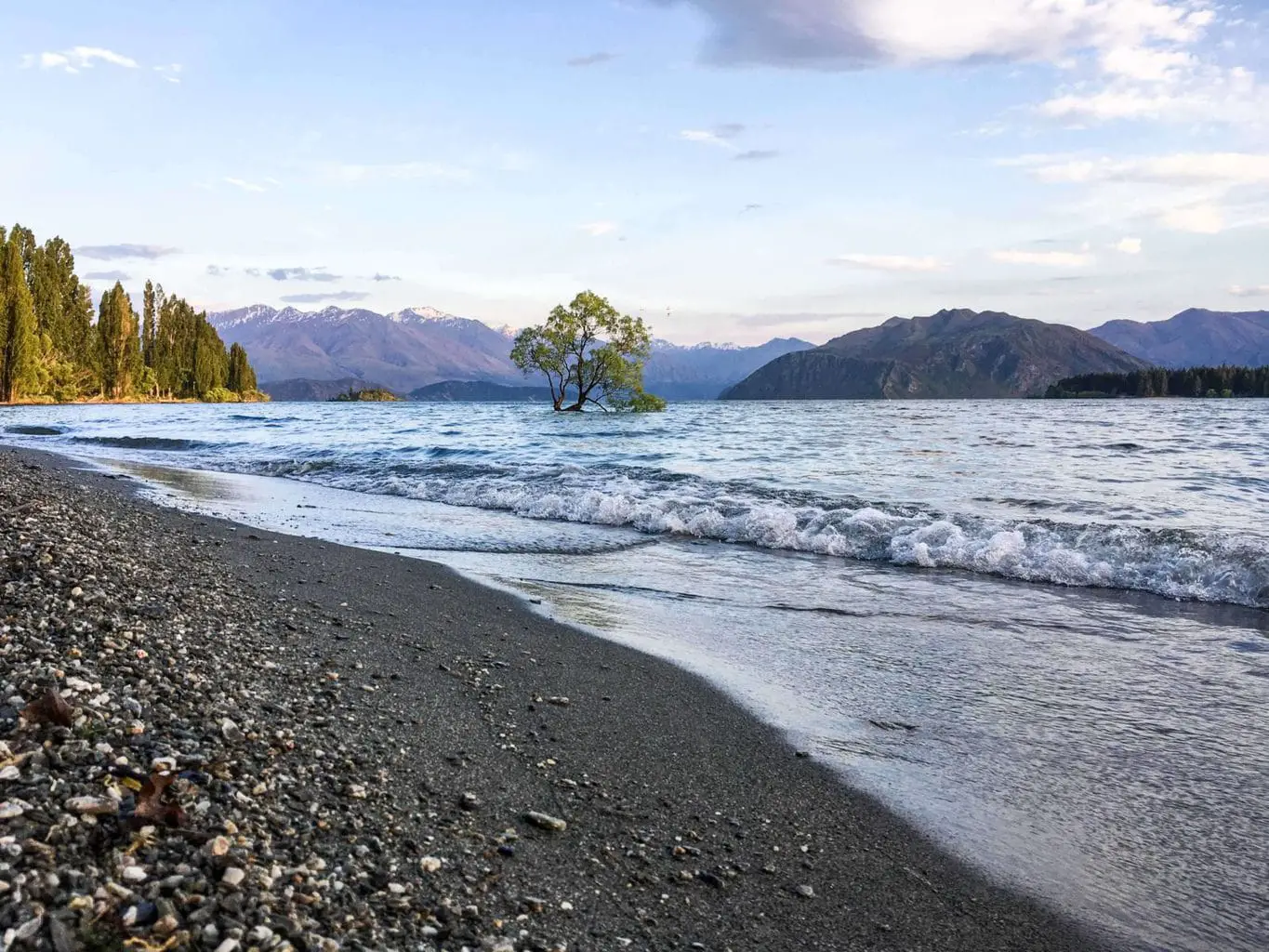
A can’t miss stop on the South Island of New Zealand is Wanaka. This small town is nestled on the shores of Lake Wanaka just outside Mount Aspiring National Park. If you’ve come to experience the natural beauty of New Zealand, you are spoilt for choice in Wanaka.
But the most famous spot in Wanaka is That Wanaka Tree, New Zealand’s most famous tree and an iconic landmark. This 100-year old willow stands in Lake Wanaka and has become one of the most iconic places in New Zealand. But you can enjoy swimming, kayaking or paddle boarding in the lake, too.
And another New Zealand landmark is only a 20-minute drive away, the hike up Roy’s Peak. This strenuous trail is nothing but endless switchbacks up to the famous view over Lake Wanaka and Mount Aspiring. But what a view! Parking is limited so get there early. And sunrise from the top is an amazing experience.
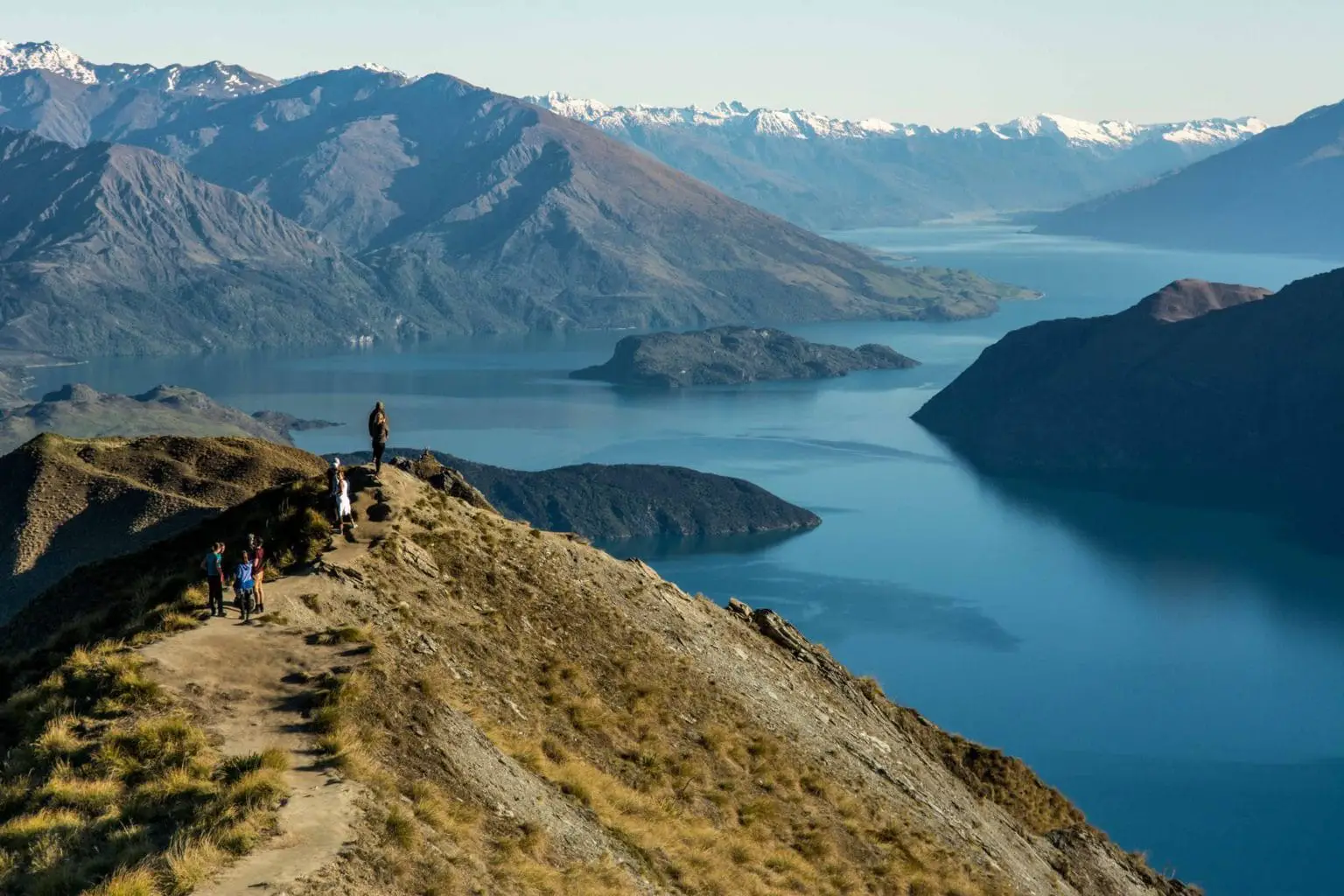
Wanaka also serves as the gateway to Mount Aspiring National Park. A wonderful day out is driving the Haast Pass (State Highway 6) which connects Wanaka to the West Coast. Along the way, you can experience the turquoise waters of the Blue Pools and many waterfalls including Thunder Falls.
With so much to do in the area including numerous local hikes, including Diamond Lake and Mount Iron, you should budget 2 to 4 days in Wanaka. And in the evenings, Wanaka has lots of unique shops and restaurants to enjoy. It’s also a great place to restock on supplies.
Tunnel Beach, Dunedin
Explored by Ali from Ali’s Adventures
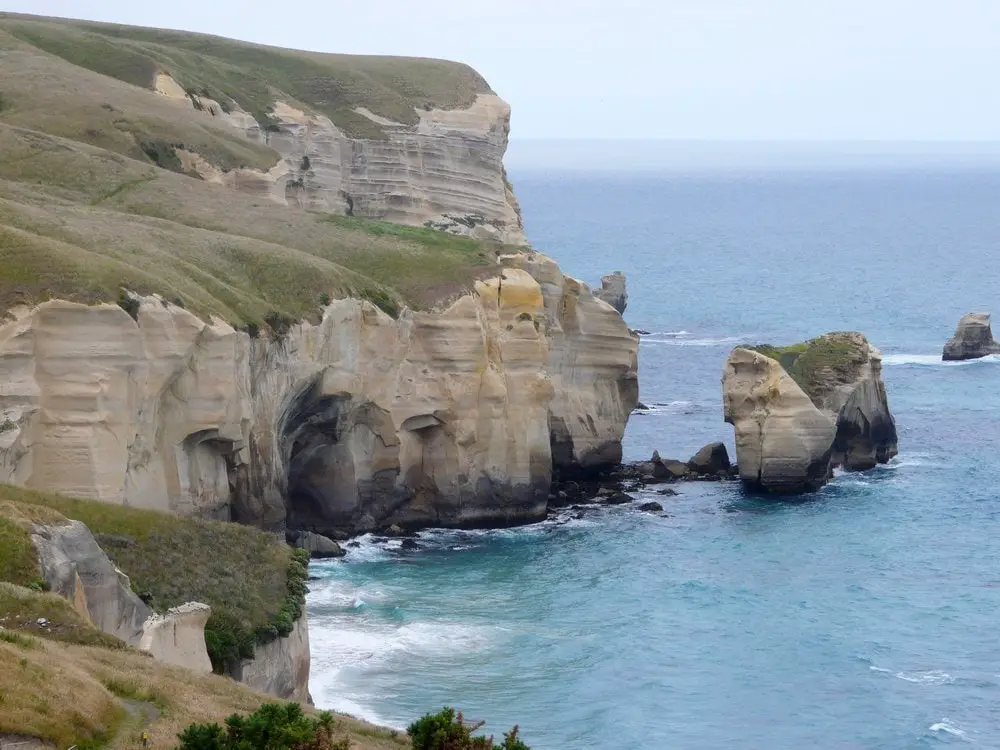
New Zealand is a wonderful country for enjoying nature. On the outskirts of Dunedin, on the south island, lies Tunnel Beach, and though it takes some effort to get there, it’s totally worth it. The road is located above the beach, so you have to hike down a trail to get there. The trail winds through grassy areas and reveals the rocky cliffs of the coastline. Narrow peninsulas jut out into the ocean, and you can see how years of wind and waves have shaped the terrain.
Eventually you’ll come to a tunnel that was dug through the rock and stairs have been added. This is where Tunnel Beach gets its name. Continue down the stairs in the tunnel, and you’ll reach the small sandy beach. Don’t expect to go swimming here though. Despite being a beach, at this latitude, the water is very cold even in the summer. After you’ve enjoyed the views and the interesting landscape, give yourself plenty of time for the steep uphill climb back to where you started. A sign claims it takes 45 minutes to walk back up, and we found that to be fairly accurate.
Tunnel Beach can be reached by bus from Dunedin, but the bus stop is still a solid 25 minutes from the start of the trail to the beach, and not well marked, so if you have a car, it’s easier to reach the trail.
Tongariro Alpine Crossing, Taupo
Explored by Lauren from TheDownLo.com
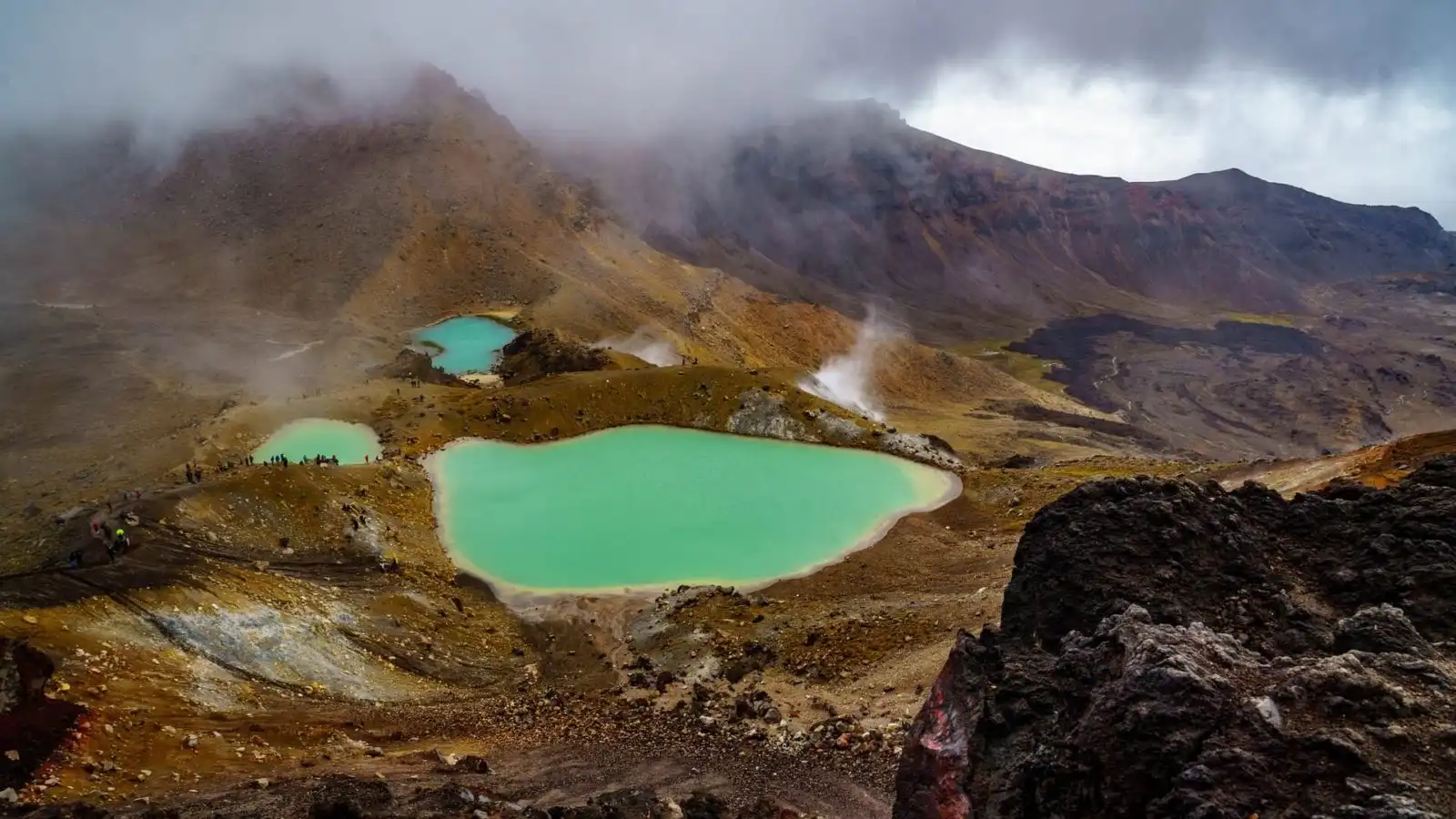
People generally think the South Island has more impressive natural landmarks, but one visit to the Tongariro Alpine Crossing outside Taupo may have you convinced otherwise. In fact, you may even recognize it from where they filmed Mordor in Lord of the Rings.
Tongariro National Park is one of the most beautiful national parks in the country and the first World Heritage Site named for its spiritual and cultural significance, it’s also been called New Zealand’s greatest day hike and tramping track.
A 19.4-kilometer journey that looks like it’s frpm another planet entirely, you’ll walk straight up the peak of multiple active volcanic craters to see molten lava, snow-capped peaks, steaming hot springs, verdant forest, and lakes so shockingly turquoise they don’t even seem real. It takes on average 6-8 hours to complete and is rated as moderate to difficult with sections like “the Devil’s Staircase” ominous and challenging but worth it once you earn those views.
Bay of Islands
Explored by Julie from Ruhls of the Road
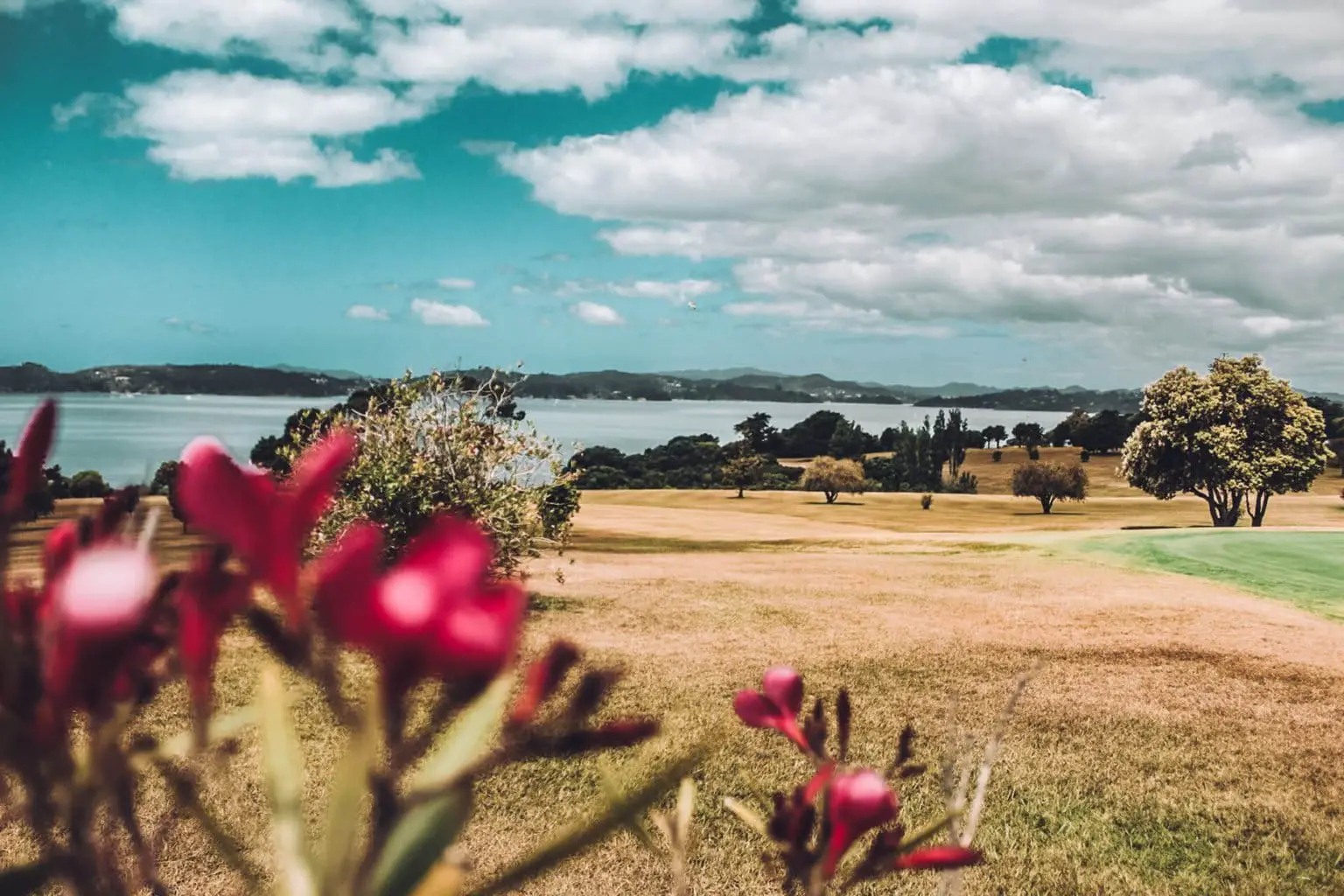
The Bay of Islands, located north of Auckland on the North Island, is one of the most iconic places in this stunningly beautiful country. Bay of Islands is a place where you can stop and stare at the incredible Pacific Ocean, soak up the sun on one of many beaches, head out on a boat for an excursion, and even check out the birthplace of New Zealand!
Bay of Islands is named for, and known for, its natural beauty. The cliffs and beaches surrounding the bay all offer a wonderful view of all of the islands dotted throughout the entire bay. Take a walk along the top of one of the hills for a bird’s eye view, then head down to a beach to soak up the beautiful weather and dip your feet in the water. If you feel like heading out on the water, there are many boat tours and excursions that will take you on any type of adventure you’d like to try. Fishing, parasailing, jet-skiing, you can do it all at Bay of Islands!
Also located near Bay of Islands is the Waitangi Treaty Grounds, known as the birthplace of New Zealand. Here you can tour the grounds, watch a Maori show, learn all about New Zealand history and culture, and have a nice picnic lunch! The Waitangi Treaty Grounds offer a full day of adventure, so if this is on your list then plan accordingly.
All in all, Bay of Islands is an incredible place to visit and is one of the iconic destinations to visit in New Zealand. The natural beauty, opportunity for adventure, and chance to learn New Zealand’s history are what makes this place so special and unique.
Related: The ultimate list of things to do in Paihia.
Lake Tekapo, Canterbury
Explored by Jennifer from Backyard Travel Family
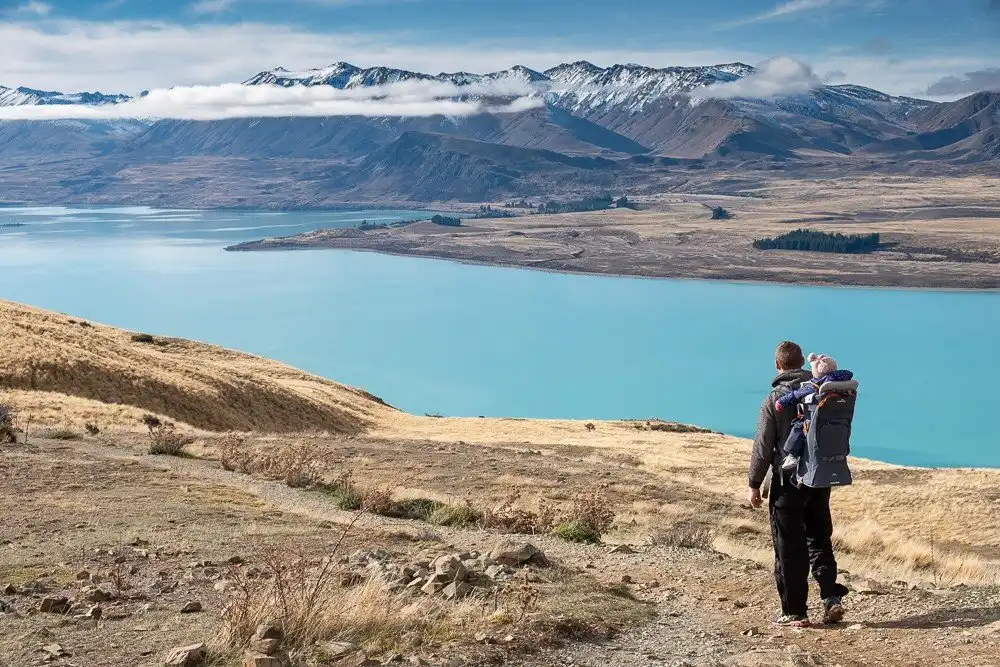
I can still remember the exact moment I first laid eyes on Lake Tekapo. The azure blue waters that glistened in the sun are just magical. If you saw Lake Tekapo on Instagram, you would assume it had a crazy blue filter added to make it that blue. But I’m here to tell you that this is just Mother Nature and it’s not a filter at all.
Lake Tekapo, located 3 hours south of Christchurch, is a beautiful glacial lake that shines in the shadow of the Southern Alps.Winter is my favourite time to visit, as the snow on the mountains and their reflection in Lake Tekapo is a match made in heaven. You can lie back and relax at the amazing views from the comfort of the Tekapo Springs Hot Pools. Or if you are after an active pursuit, walk from the hot pools to the top of Mt John for the incredible views in this photos.
While you are there, you can’t miss the historic Church of the Good Shepherd, one of the most photographed landmarks in New Zealand.
Insiders tip: The church is always busy during the day, as this is where tourist buses stop, so stay overnight and enjoy it at sunrise or sunset when the crowds have gone. I think its most beautiful in the winter, with the mountains in snow in the background.
Muriwai Beach & Gannet Colony
Explored by Maureen from So Many Places! So Little Time!
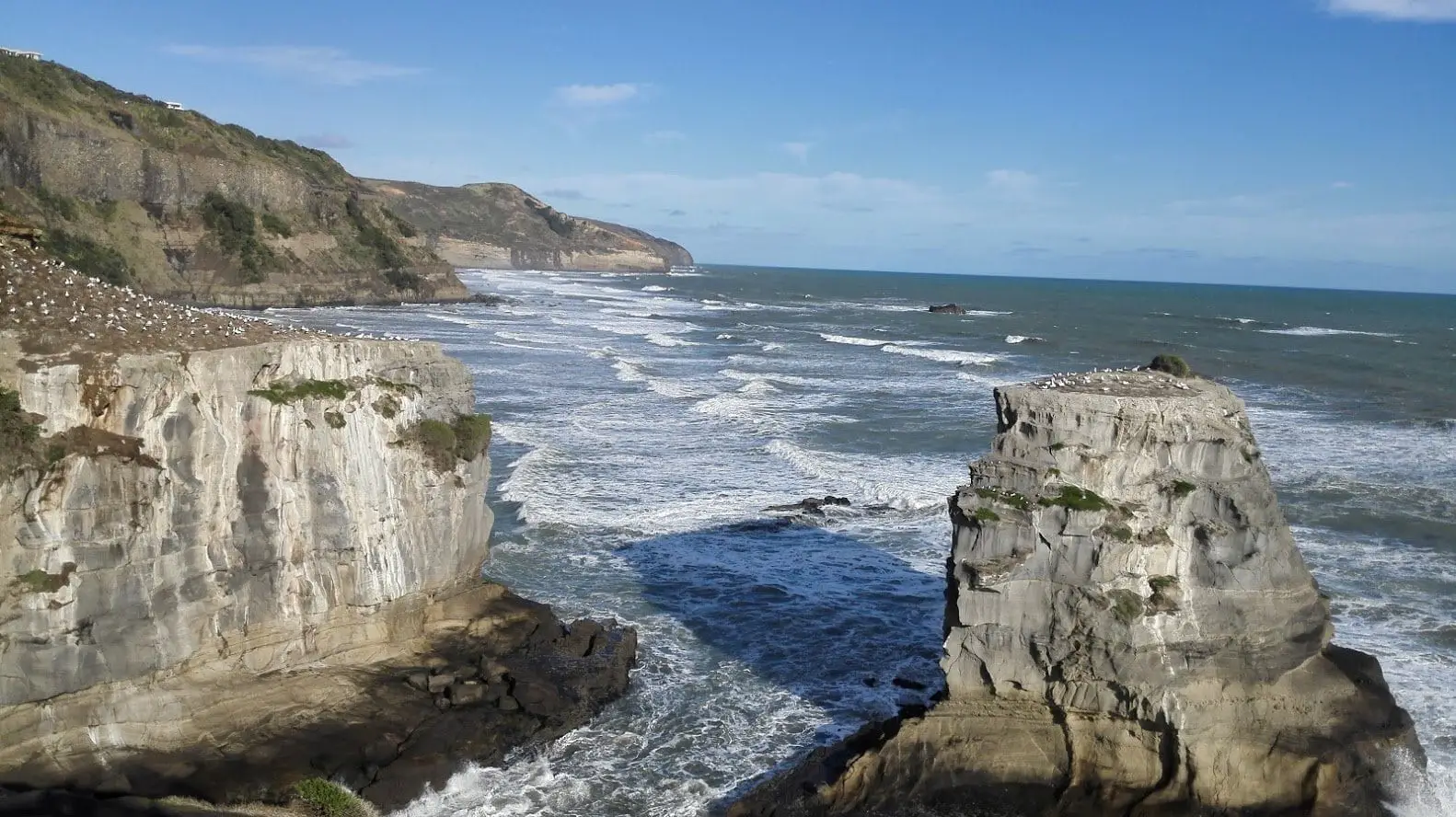
While you are in Auckland take an hour’s pleasant drive from Auckland City through green farmland, a couple of rural villages, vineyards, orchards, and some native bush, out to the rugged west coast to Muriwai Beach. This is a stunning, windswept, black sand beach that stretches along 50 km of the Tasman Sea Coast and is much loved by experienced surfers for its huge swells and rolling breakers.
It’s a great beach to walk along and shake off that jet lag, but one of its main attractions is the gannet colony on the cliff tops at the southern end of the beach. Drive up the hill opposite the beach cafe to the parking area and follow the well-signposted tracks to the viewing platforms that give great views not only of the beach and out to sea, but also close up views of the large gannet colony.
If you visit between August and March you can expect to see (and smell!!) about 1200 pairs of gannets mating, and nesting on the exposed windblown clifftops, and from the easily accessed viewing platforms you can observe them going about their daily business. They are large birds with a wingspan of around two meters. If you visit in December and January you will get a chance to see the chicks too. It’s quite a unique sight and well worth the trip.
If you get the chance while in Auckland we also recommend a trip to Great Barrier Island for its Dark Sky Sanctuary.
Kawarau Gorge Suspension Bridge, Queenstown
Explored by James from the Travel Scribes
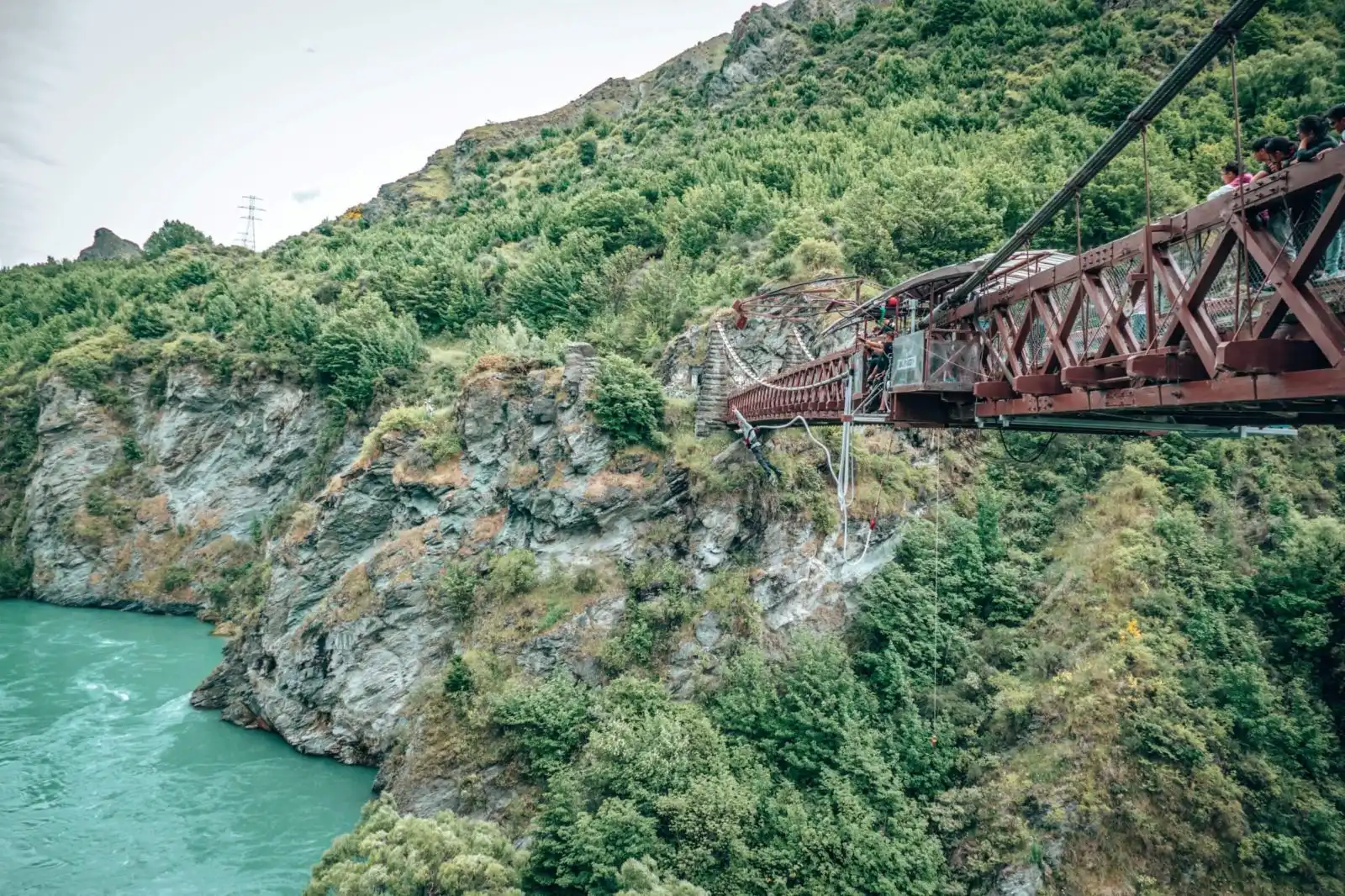
Did you know that the sport of bungy jumping was invented in New Zealand? And the Kawarau Gorge Suspension Bridge is definitely one of the biggest landmarks in New Zealand, because it’s the first ever commercial jump in the world!
The bridge, located 43 metres above the raging Kawarau river, was designed by Harry Higginson and completed in the late 1880’s, as a way to get to the very lucrative goldfields in Central Otago. It was later replaced by a new highway bridge and so become more of a tourist attraction, as bungy jumping came to the fore and runners started using it as part of the Queenstown Trail.
Today the bridge is exclusively used by AJ Hackett Bungy (the inventors of the sport) for thrill seekers to throw themselves off the side and touch the water below. Those who don’t want to try a bungy jump could instead ride the zipline, a 130m line racing along at 60km an hour.
If you are keen to see it in all its glory, we suggest you make it part of your Queenstown itinerary – we’ve got you covered with a comprehensive guide to the town.
Moeraki Boulders, Moeraki
Explored by Megan from Red Around the World
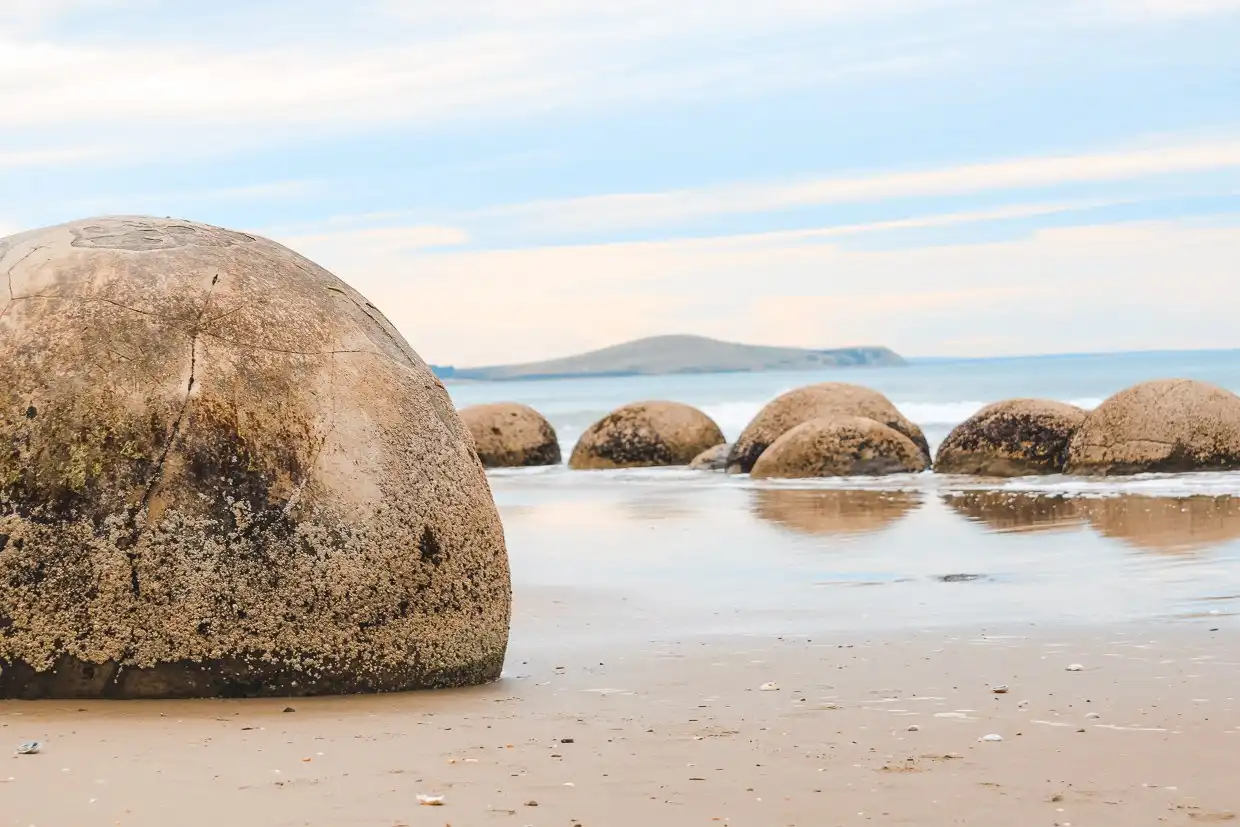
The Moeraki Boulders are a geologic wonder on the coast of the Otago region. The giant boulders are almost perfectly round rock formations on the Koekohe Beach of the Moeraki Peninsula. They started forming 60 million years ago to become what they are today. It’s just a short walk from the parking area down to the beach, so most people should be able to go.
They’re the perfect roadside stop if you’re passing through the area, especially to or from Dunedin. There is a $2 NZD entrance fee and the best time to go is at low tide so you actually can see them. There is one trail from the nearby cafe to an overlook of the boulders and another that actually takes you down to the beach. While they may not be as jaw-dropping as other iconic landmarks in New Zealand, like Mount Cook or Milford Sound, they are still definitely worth visiting, especially if you’re in the area.
Arrowtown, Otago
Explored by Delilah from Our Travel Mix
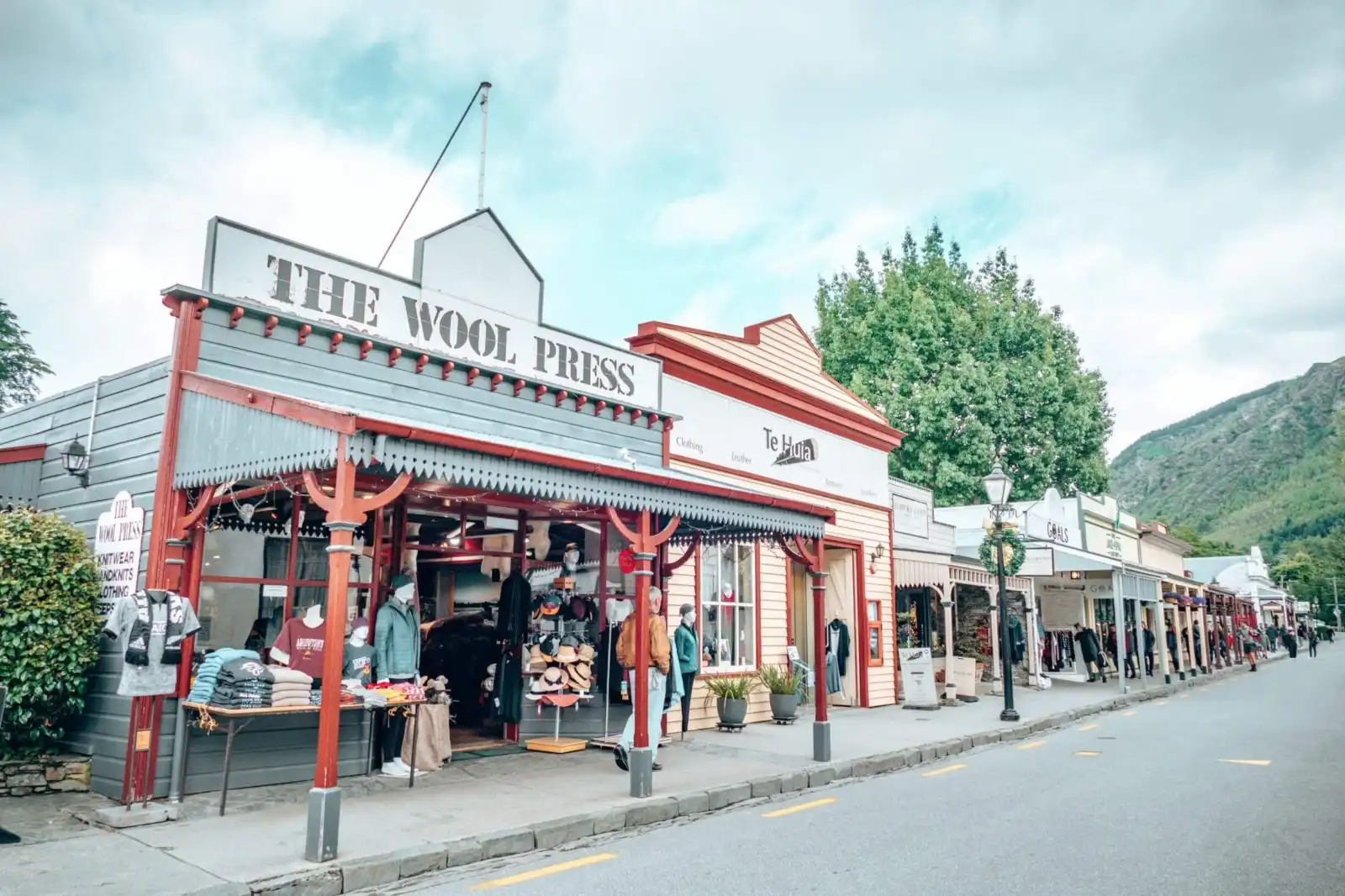
Arrowtown is a charming, little town located just a 20-minute drive outside Queenstown. There’s so many things to do in Arrowtown, plus it’s incredibly easy to get to – you have no excuse not to visit this iconic place!
Aside from its delightful atmosphere, Arrowtown is known for its historical significance. In the 19th Century, opportunists flocked to the town to mine the recently discovered gold in the river. This influx of visitors resulted in the town that is there today.
Heading down through the village you can reach the river where you’ll find an old police station and jail. These buildings are interesting to explore and offer a great opportunity for photography. Sunrise is the best time to visit as it’s a popular tour group destination. After this, panning for gold is a must. If you’re lucky, you’ll pick up a few small pieces – but don’t be disheartened if you don’t find any, most people don’t!
Aside from the typical tourist activities, our favourite thing to do in Arrowtown is to walk down the main village and visit the cafes and eateries. It is such a beautiful little town and the cafes are lovely and peaceful.
Marlborough Wineries
Explored by Catherine from Traveling with the Littles
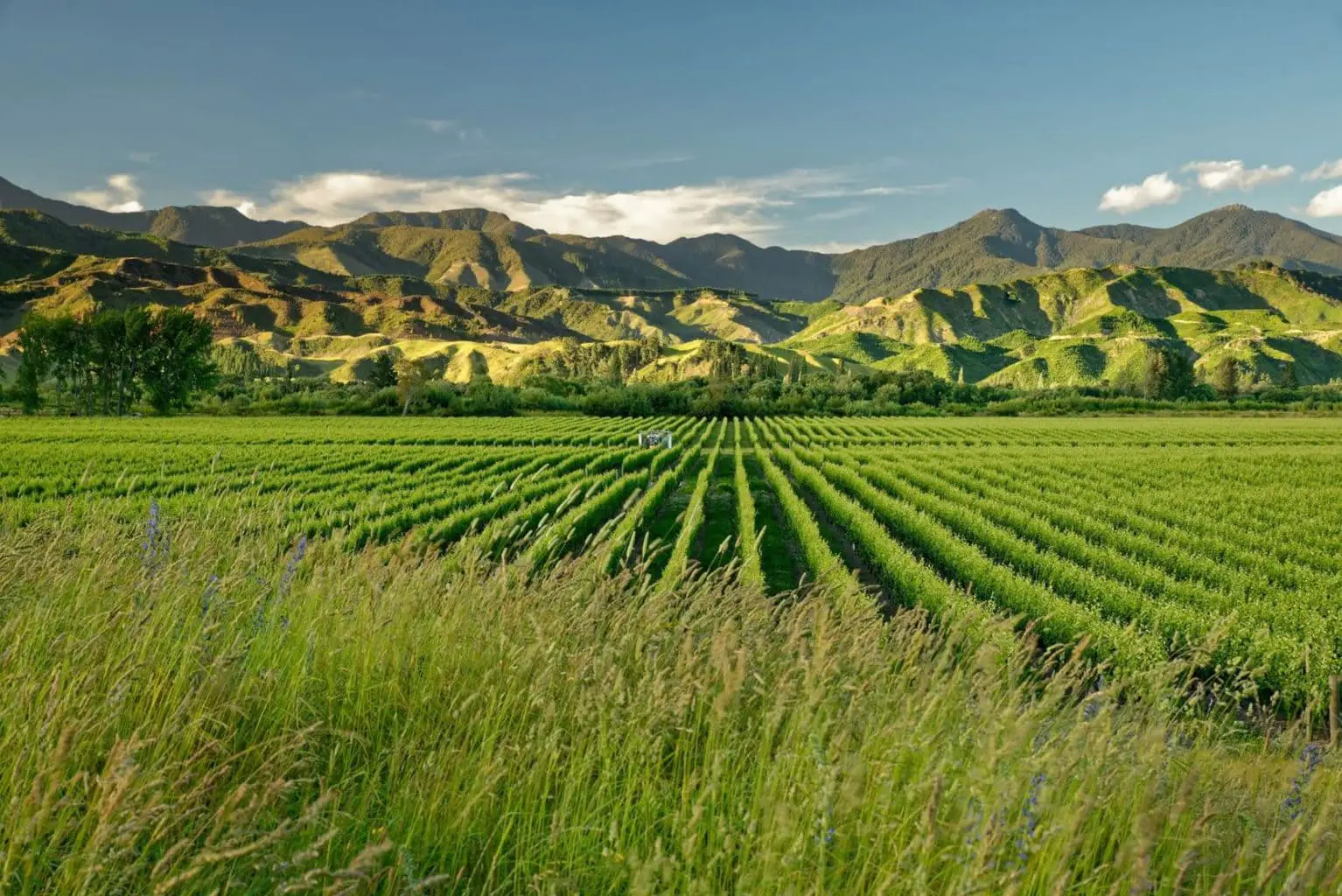
One of the most beautiful and iconic places in New Zealand is the Marlborough region. Nestled in the north western corner of New Zealand’s south island, the Marlborough region is most well-known for its wine. The rolling hills of the Wairau Valley are the primary wine-producing areas in the region. You can access the Wairau Valley from Renwick via Blenheim. I recommend taking a self-guided bike tour, and leisurely exploring the various vineyards.
What makes the Marlborough region so remarkable are its unique Sauvignon Blancs and Pinot Noirs. There’s a range in vineyard sizes, so you can experience the intimacy of the smaller vineyards but also visit the spectacle of some of the larger vineyards. Another unique thing about the Wairau Valley is that it is surrounded by the Richmond Mountain Range, so while sipping wine, you have a stunning, mountainous backdrop. If you catch a beautiful day, touring the Wairau Valley will be a highlight of your trip to New Zealand.
I was not a wine drinker before this experience, and New Zealand Sauvignon Blanc is now my drink of choice. If you are ever down in New Zealand, I highly recommend making time for a tour around the Wairau Valley; you will not regret the decision!
Bonus: If you’re in Marlborough, definitely plan a day in Picton and go see the Edwin Fox Maritime Museum, which has one of the oldest wooden troop ships in the world, set in Dunbar Wharf.
The Beehive, Wellington
Explored by Lee from the Travel Scribes
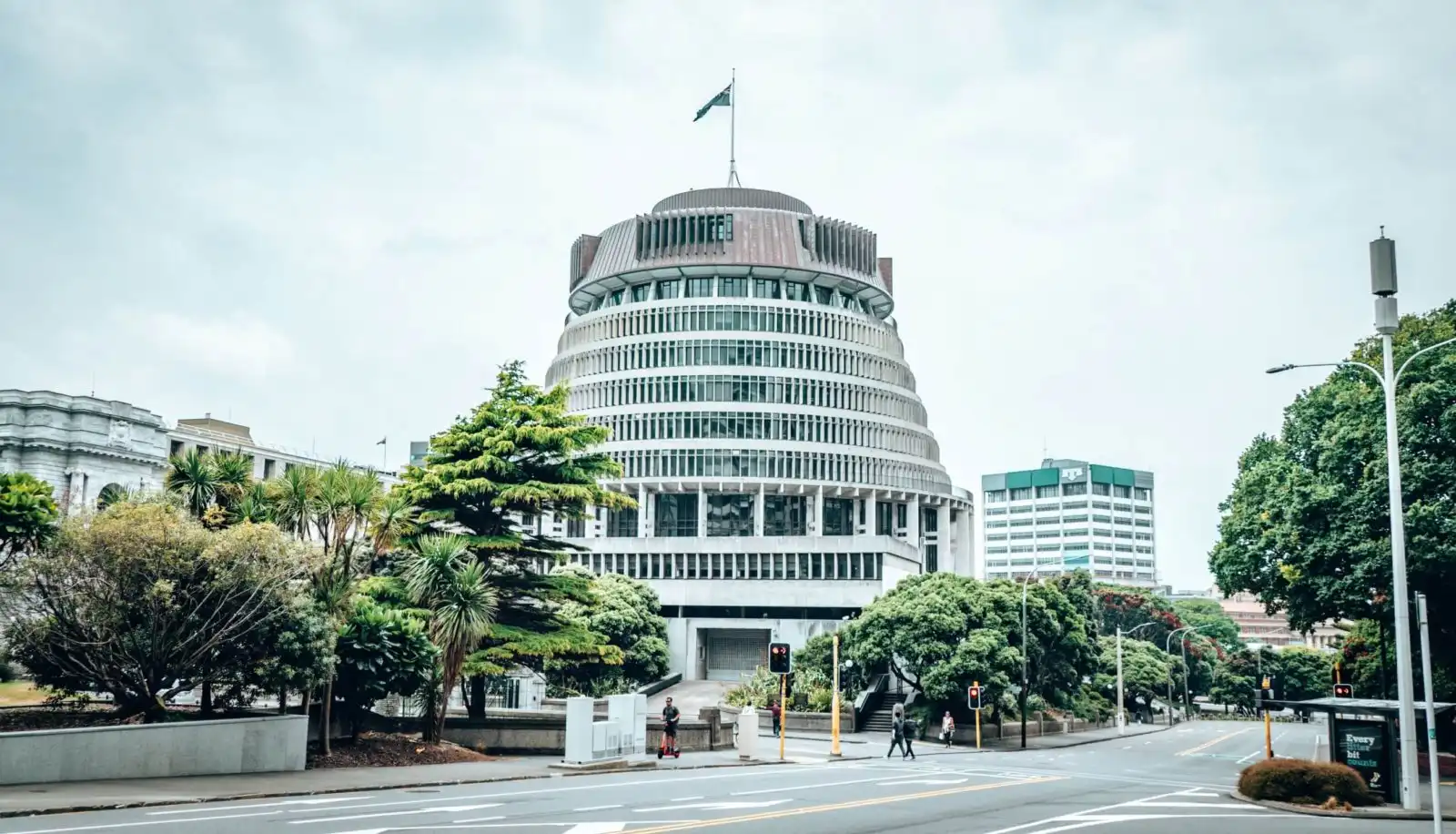
Aptly named due it’s cylindrical, almost-honeycombed shape, the Beehive is a major landmark in New Zealand and one of the most well-known sights, standing tall in the country’s capital city, Wellington. It’s not much of an ‘attraction’ to visit but its definitely one of the most recognizable buildings in the country.
The Beehive, located on the corner of Molesworth street and Lambton Quay, is actually the executive wing of the nation’s parliament so is home to the offices of the prime minister and other leading ministers. And, because of that, the term is almost interchangeable for ‘leadership’ i.e. the prime minister and their team are often called ‘The Beehive’.
So, what’s the history of this iconic building? The building was proposed in the 1960s as an extension of the existing Parliament House and was built over a decade, between 1969 and 1979, although technically only completed in 1981. Nowadays the finished building is 72 metres (236 feet) tall with 10 floors peeking out above ground and 4 floors below ground.
Larnach Castle, Dunedin
Explored by Holly from Globeblogging
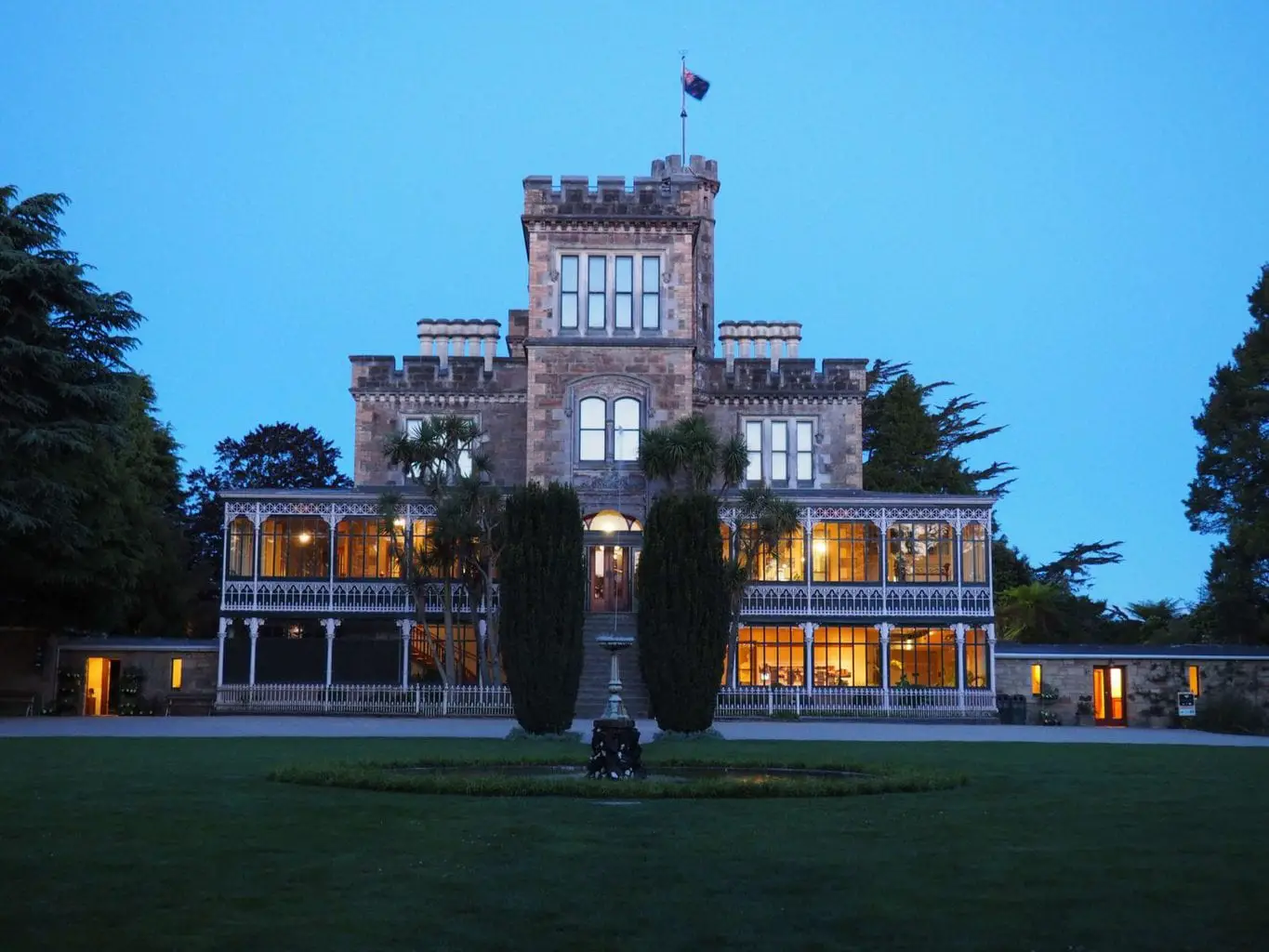
You wouldn’t expect to find a castle in New Zealand, but given the strong Scottish heritage of the South Island’s Dunedin its perhaps not so much of a surprise. If you happen to be passing through Larnach Castle is one of the best things to do in Dunedin, and if you need a place to stay you can even stay on the grounds.
Situated on a stunning 35 acre property overlooking the Harbour and the Otago coast, the building itself is strongly fashioned after the English family home of its creator, with strong gothic and Australian colonial influences incorporated. Commencing construction in 1870, materials were shipped from all over the world and pulled by ox sled uphill to the property. Ownership passed out of the family in the early 1900’s and despite finding a number of uses, including a hospital and an asylum, the property was neglected and almost ruins when purchased by the current owners. It has been diligently restored to its original glory since, with great effort taken to locate the original furnishings and adornments stripped from the house over the years. The castle and grounds are open to visitors all year round and worth checking out for the spectacular views and piece of Dunedin history.
So what do you think of our list of iconic places and famous landmarks in New Zealand? Let us know in the comments below if there are any that you think we missed, or get in touch with us here.
If you’re interested to check out other landmarks around Oceania and Asia, check out some of the articles below:
- The Top 10 landmarks in Australia
- 21 Iconic building and landmarks in Singapore
- Famous places in Myanmar
- Most iconic buildings and landmarks in Vietnam
- The ultimate Indonesia landmarks
- Thailand’s 21 most iconic places
- Iconic places and famous landmarks in Malaysia
Also, if you’re looking for a list of great things to do in New Zealand, do check out some of our New Zealand travel guides for everywhere from Hanmer Springs to walking the Tasman Glacier near Mount Cook!
Want to save this for later? Why not pin it…
